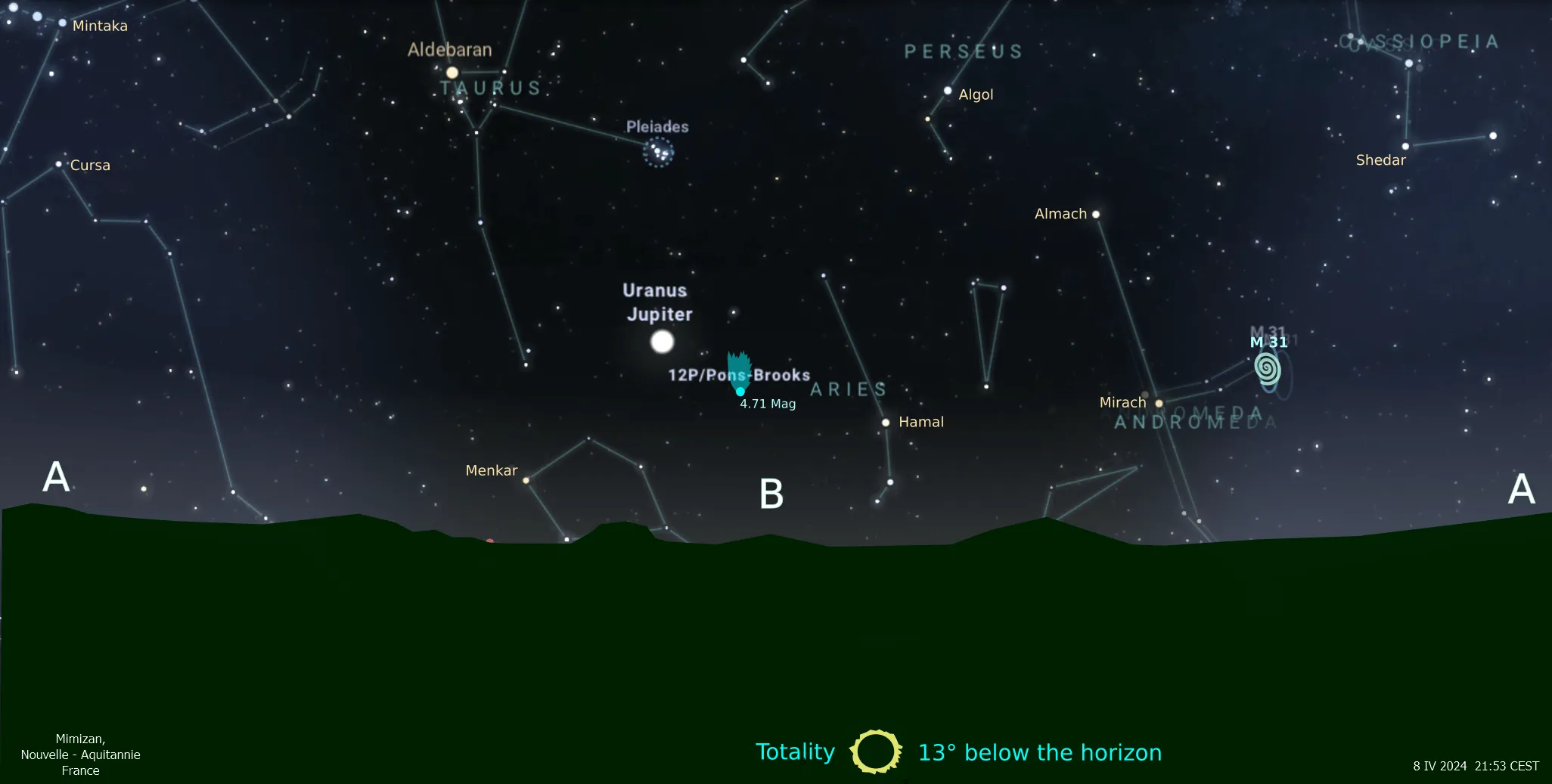The 2024 total solar eclipse is undeniably the most significant event in North America in the next year. The so-called Great Nort American Elipse or at least the Great American Eclipse will be visible in a wide swath from Mexico to Canada (New Foundland). Indeed, these areas aren’t the only ones, where the totality will occur. In fact, these are only on the grounds, but there is a distant eclipse pathway possible to observe from the ocean. The totality starts with a length of 2m06s north of Cook Islands (next to Penhryn Atoll), culminates with 4m28s near Torreon in Mexico (close to Nazas town), and finishes at North Atlantic with a length of 2m13s.
LINK TO MAIN 2024 TOTAL SOLAR ECLIPSE MAP
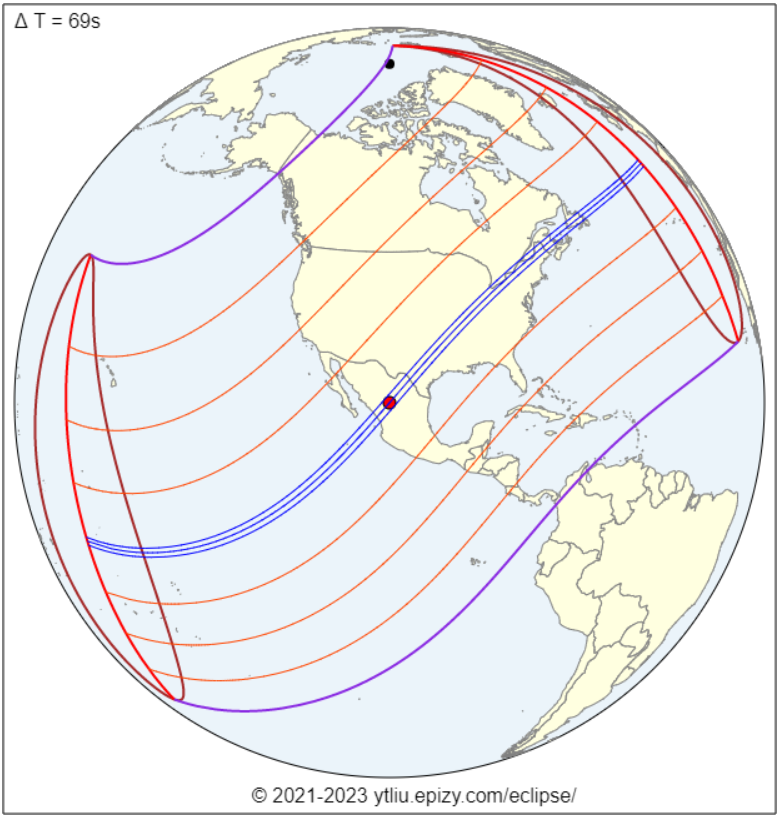
The major eclipse event is a widespread subject of discussion for American astronomers and popularized science. Most of the information is available on the following websites:
https://www.greatamericaneclipse.com/
https://www.facebook.com/greatamericaneclipse/
https://eclipse.aas.org/
https://nationaleclipse.com/
https://www.eclipsewise.com/solar/SEprime/2001-2100/SE2024Apr08Tprime.html
and several others.
The finish of the totality at Northern Atlantic with the duration of 2m13s will be the crucial element of this celestial event from a European point of view.
Unlike our American colleagues, NOBODY tries to draw attention to the same event in Western Europe, except for just one sentence saying, that the partial solar eclipse will be visible at the northernmost and westernmost bits of the continent.
THE PRIMARY GOAL OF THIS WEBSITE is to make people aware of what is going to happen on the same day in EUROPE.
Let’s get started then.
1. GENERAL INFORMATION
The solar eclipse of April 8, 2024, belongs to Saros 139, where is « placed » between the eclipse of March 29, 2006, and the eclipse of April 20, 2042. What is most interesting, the Saros 139 includes also the longest possible total solar eclipse with a duration of 7m29, which will occur on July 16, 2186, at Central Atlantic.
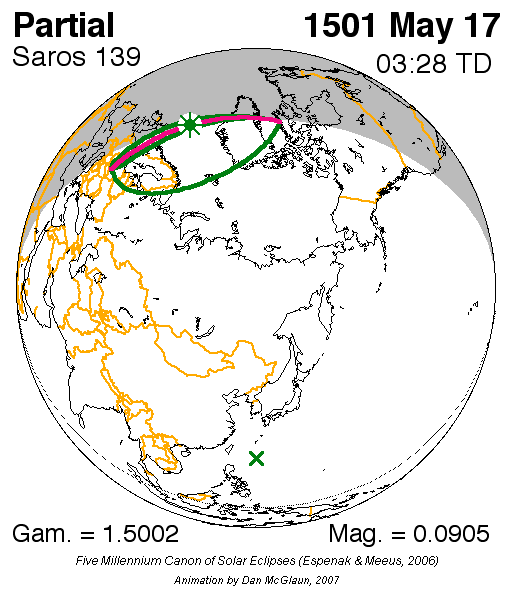
The eclipse path begins in the Pacific Ocean, next proceeds through Mexico, the USA, and Canada with its finish at the North Atlantic. The exact region of the Atlantic, where the eclipse path « terminates » is the West European Basin about 1500km west of the European landfall. The greatest duration of this eclipse is 4m28s near the Nazas town in Mexico. At the North Atlantic, the same duration is 2m13s, which can be considered as the long one for the horizontal type of solar eclipses.
On the other note, the path width near the greatest eclipse point is approximately 198km. The path width at the end of the totality west of Europe is calculated at around 141km.
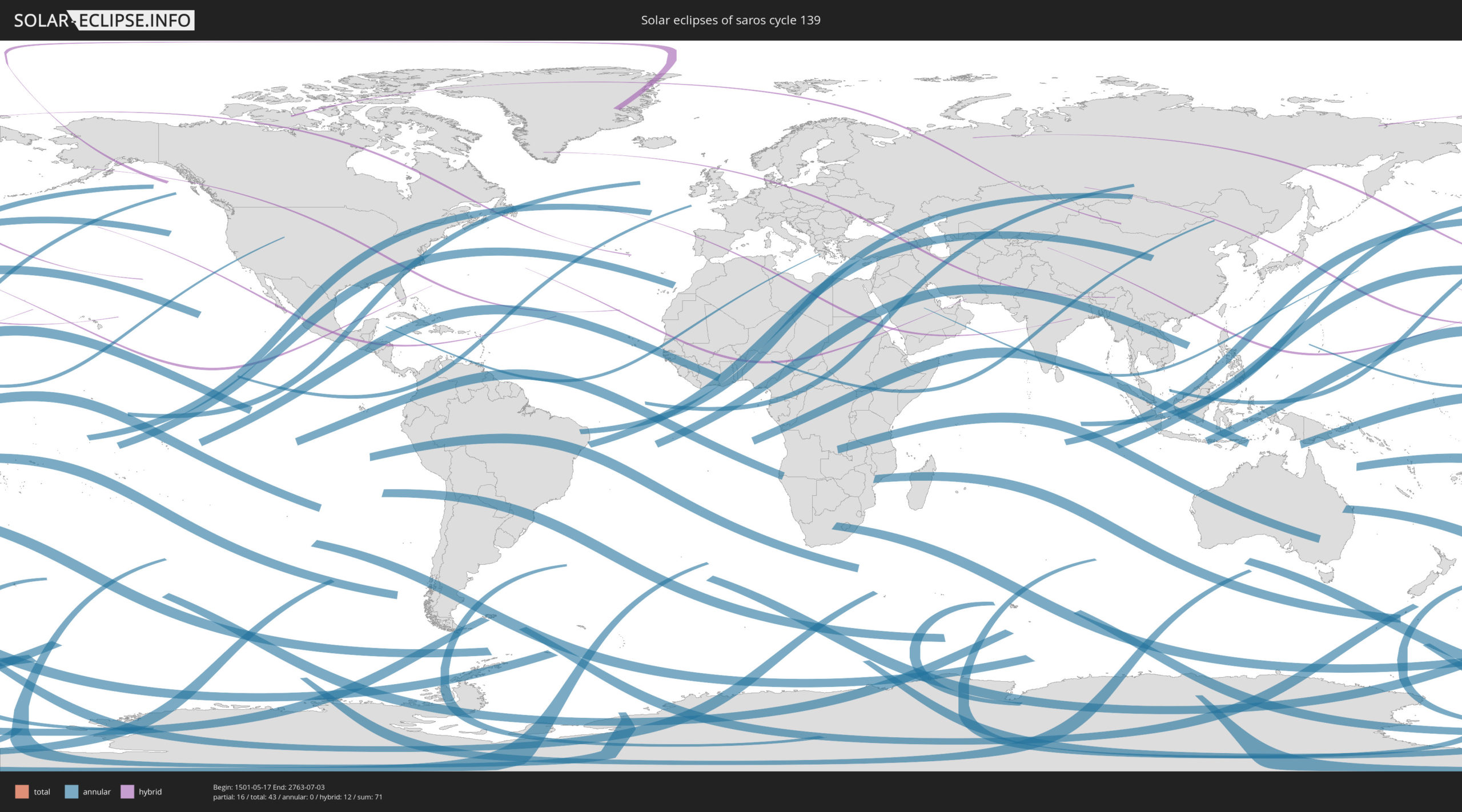
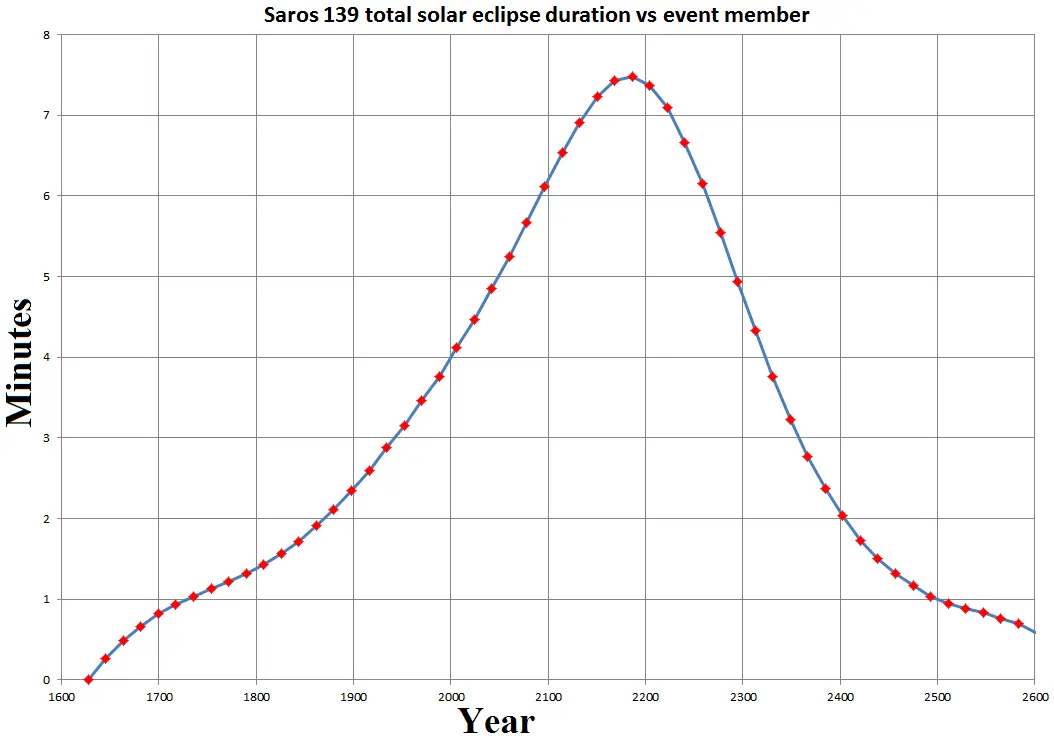
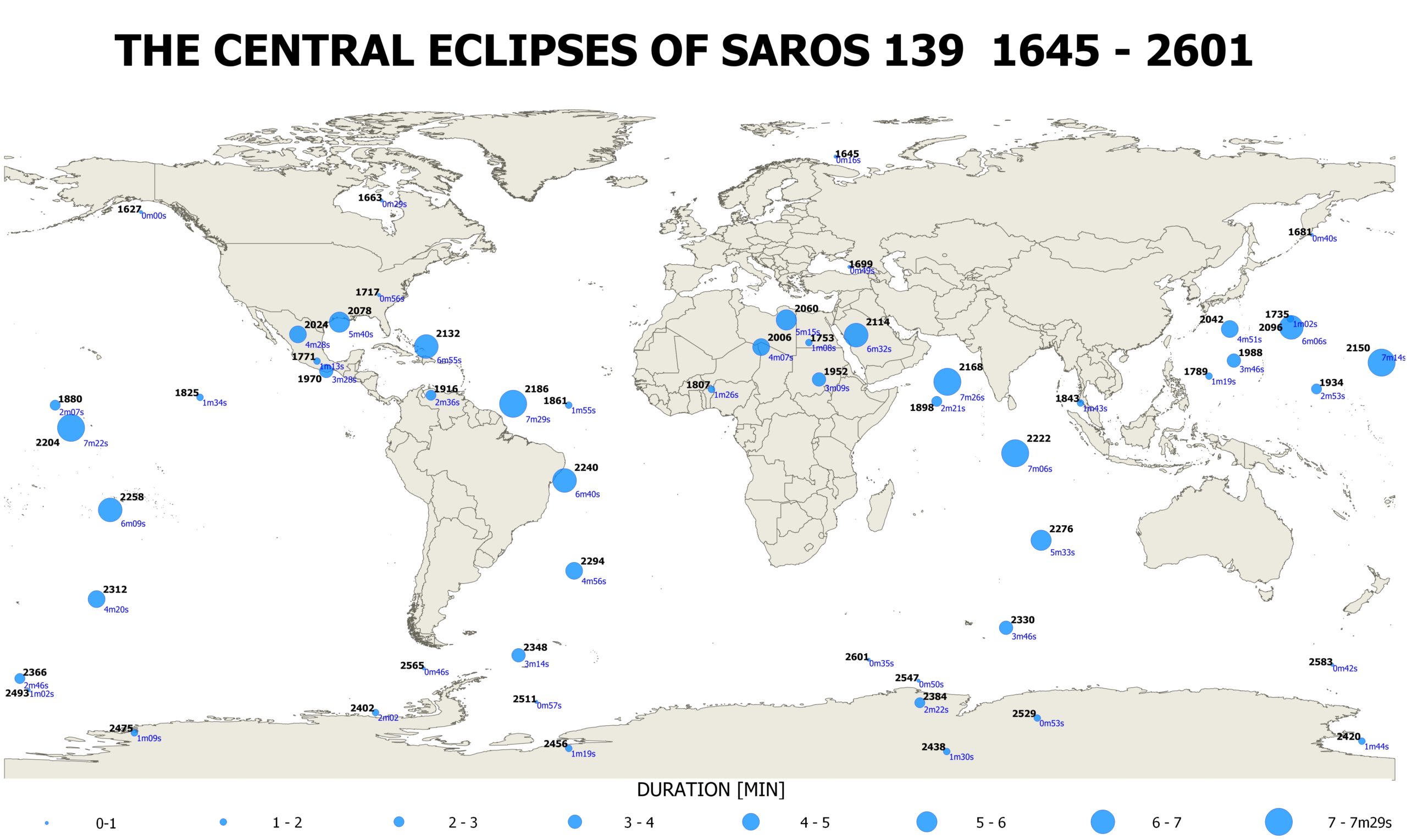
2. PARTIAL PHASE
There are areas in Western Europe, which will see the partial phase of the eclipse. In fact, most of them will experience just the beginning of the eclipse shortly before sunset. As the lunar disk covers the solar one from the west, the limit of the first contact might not be authentic, because all the areas falling along this line will see the sunset without the eclipse progress.
2.1 Svalbard
The eclipse event is to be seen at almost the entire Svalbard grounds considering the first contact onwards. The 2 islets where the event won’t be visible to observers are Bear Island and Hopen.
The majority of the archipelago will see a very small partial phase with an obscuration of just 5% at the very north (North East Land) and approximately 9% at the central part of Spitsbergen Island (Nordenskjøld Land National Park) taking into account just the geometrical sunset. When the true sunset is concerned, the observers will get almost 10% obscuration near the southernmost point of Spitsbergen Island (Sør-Spitsbergen National Park). The whole event will take place very low above the horizon on the western and northwestern part of Archipelago with the 4th contact shortly before sunset.
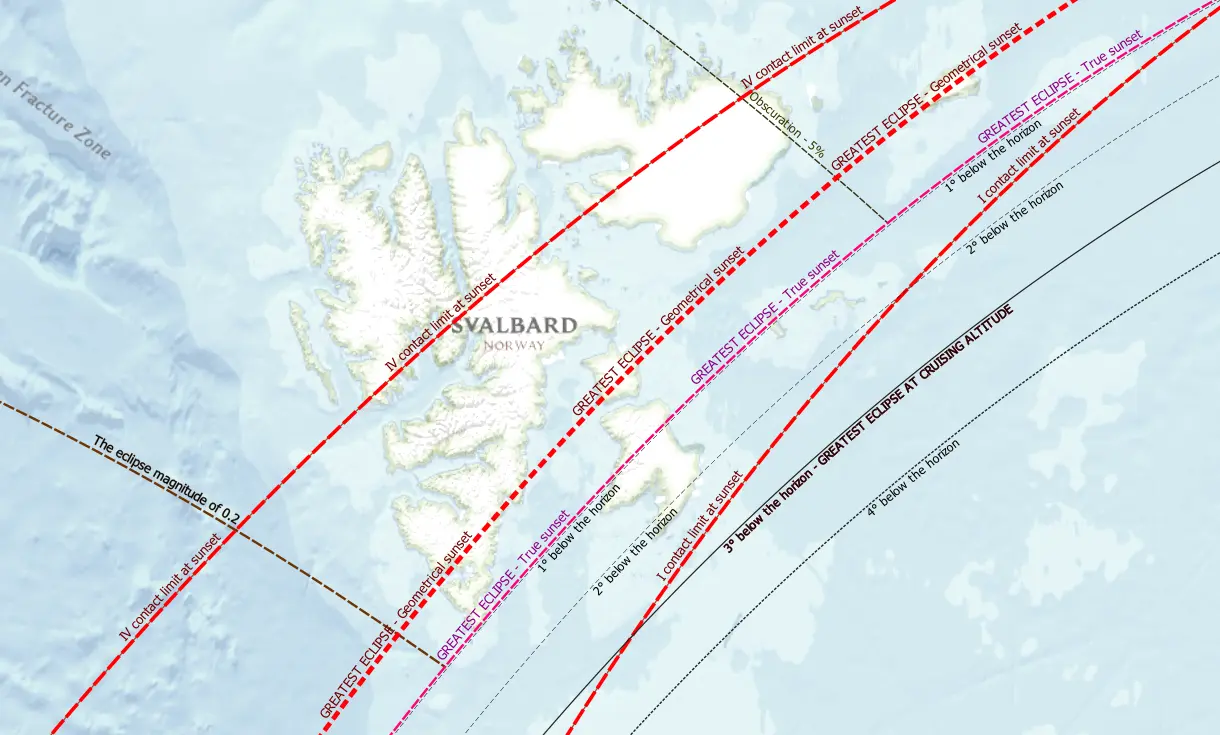
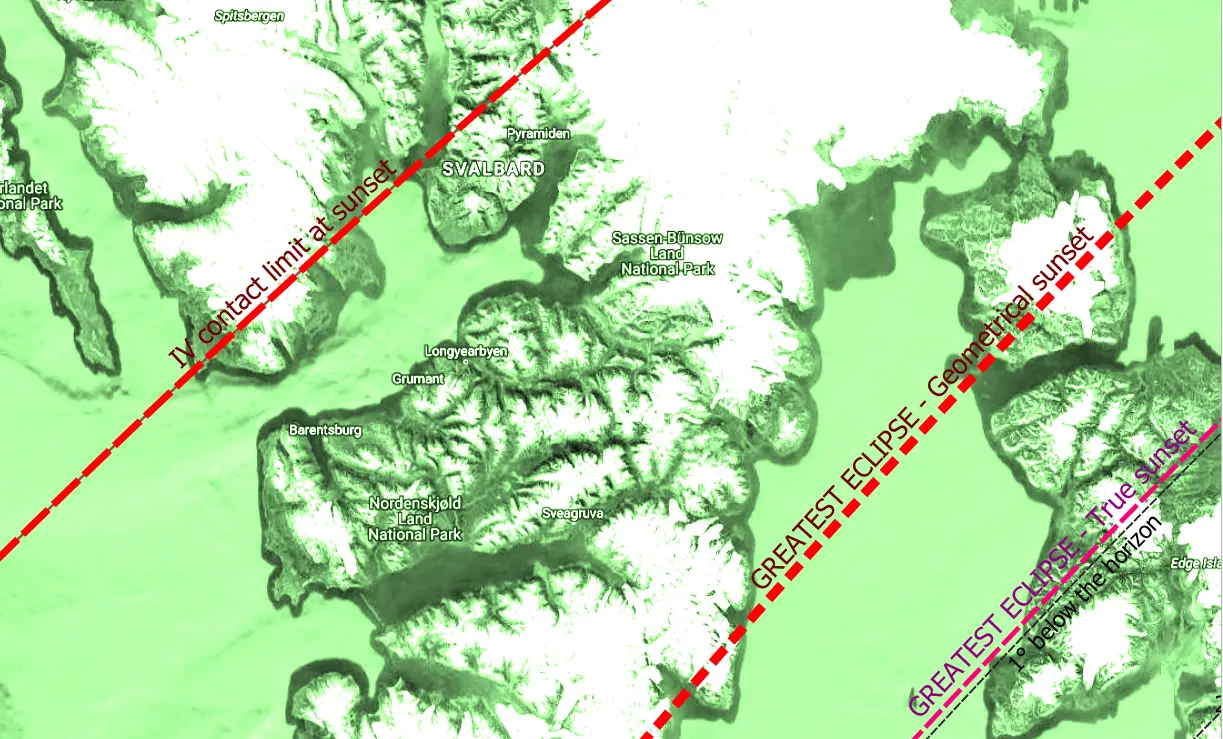
2.2 Iceland
The observers and inhabitants of Iceland will see a quite nice partial phase of the eclipse shortly before the sunset. The greatest phase will reach the obscuration between 39% at northern shores and 48% near the Vik coastal village, which is the warmest place on the whole island. Except for the westernmost parts of Iceland, especially the Westfjords Region, the maximum eclipse will occur at golden hour. with a solar altitude of not lower than 2.5 ° above the horizon.

In fact, almost two-thirds of the country won’t see the end of the event, as the Sun goes down before the last contact. Concluding, the most spectacular event is to be expected in the Eastern Region, where the maximum will be visible just 3° and less above the horizon. Taking into account the thick atmosphere and potential haze presence, the eclipse watchers could have the natural filters and reddish solar disk, who knows… The expected obscuration there is around 42%.
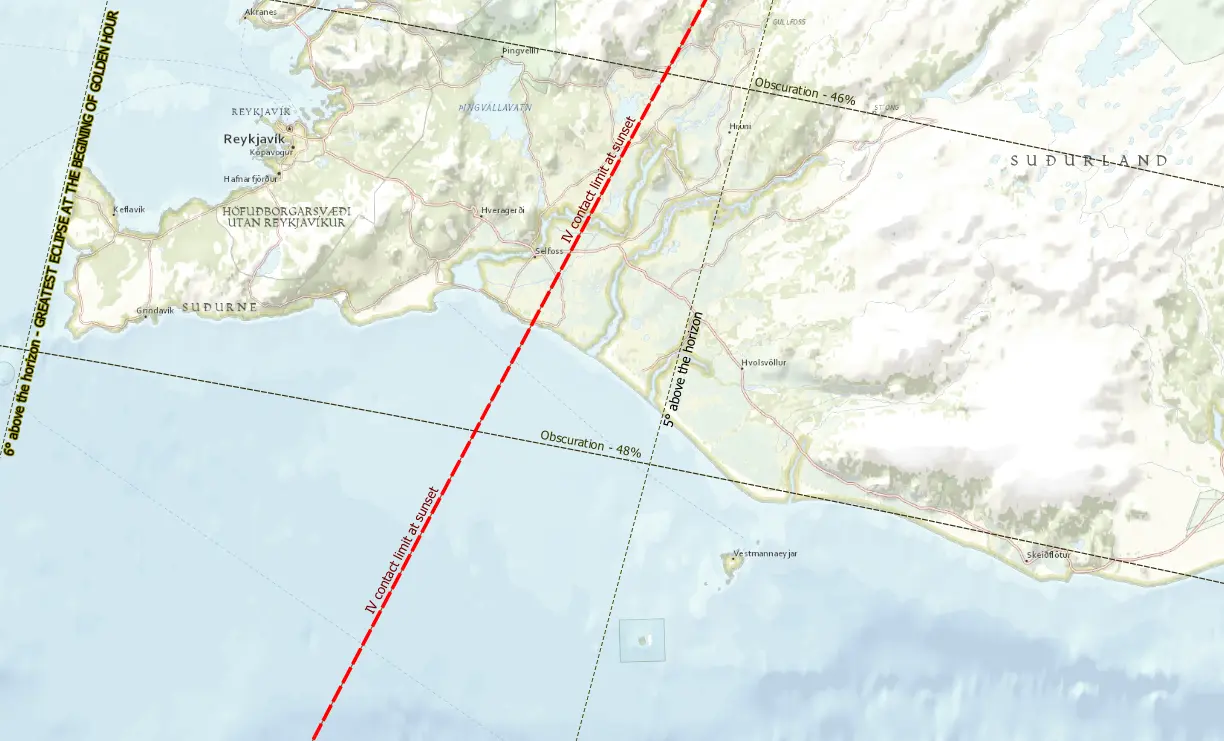
The Reykjavik and surrounding area will see the whole eclipse event with the greatest phase just at the beginning of the golden hour and the end shortly before sunset.
2.3 Faroe Islands
The partial phase of the eclipse will be visible at a whole archipelago, although nowhere the greatest phase will be reached before sunset. The estimated obscuration at sunset is to be about 45%. If the greatest phase were visible, the level of obscuration would correspond to southern Iceland described earlier.
2.4 UK & Ireland
The UK & Ireland are the area, which will rather enjoy the eclipse below the horizon. However, over two-thirds of the area should see the progress of the event after the first contact until the Sun goes down. The total visible obscuration won’t exceed 8% at the Isles of Scilly (Cornwall) and 13% at Cork County in Ireland.

If I could be meticulous, there is literally one place where the observers (if they could be any) will be able to see the greatest phase of this eclipse. It’s the Rockall islet located in the North Atlantic Ocean, which belongs to the United Kingdom’s territorial sea. The greatest phase coincides with the geometrical sunset (excluding atmospherical refraction) with the obscuration reaching almost 65%.

The Rockall islet protrudes from the Rockall Bank bathymetric feature divided from the British Isles continental shelf by the Rockall Through – deep water region. Rockall is located a bit over 300km west of the St Kilda archipelago (Outer Hebrides).
2.5 Azores
This is the best place in Europe for the 2024 partial solar eclipse experience, especially since one of the most remarkable parts of the event will be visible on Sao Miguel island, where the capital of this Portuguese region is located. The Ponta Delgada city seems to be the easiest accessible location in the region, as we consider the flight connections from Continental Portugal as well as other Western European countries. The Ponta Delgada Airport (PDL) should get roughly 62% of obscuration during the greatest phase of the eclipse, which will be visible just 1,5º above the horizon. It’s highly likely, that due to these circumstances, the view of the event will be delightful.
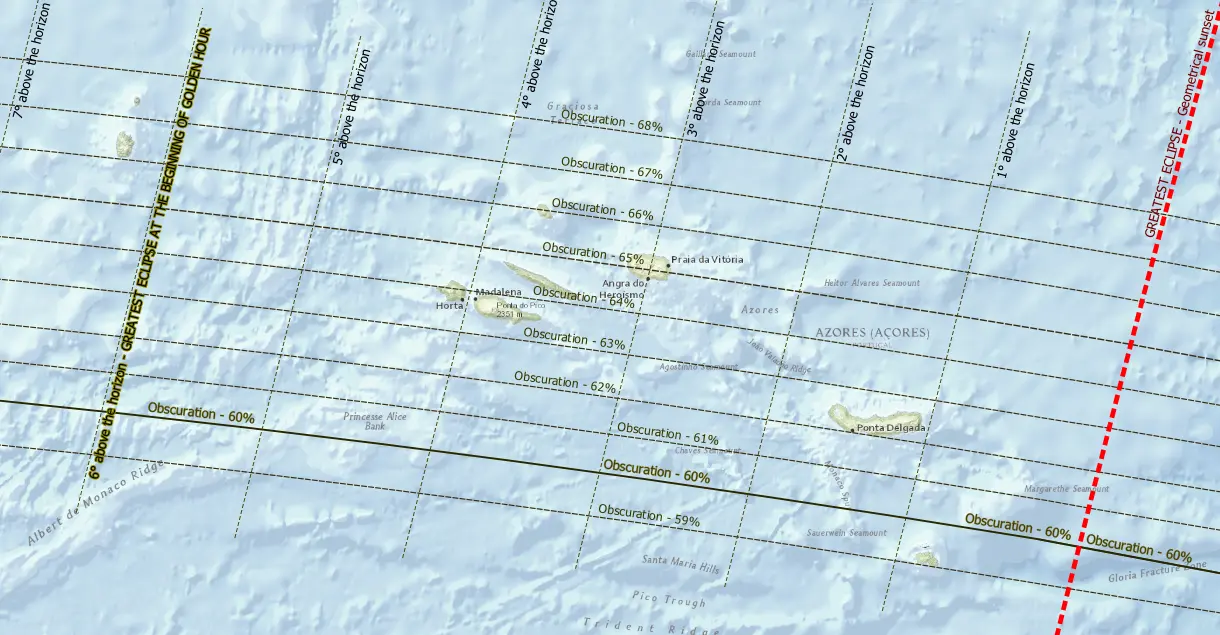
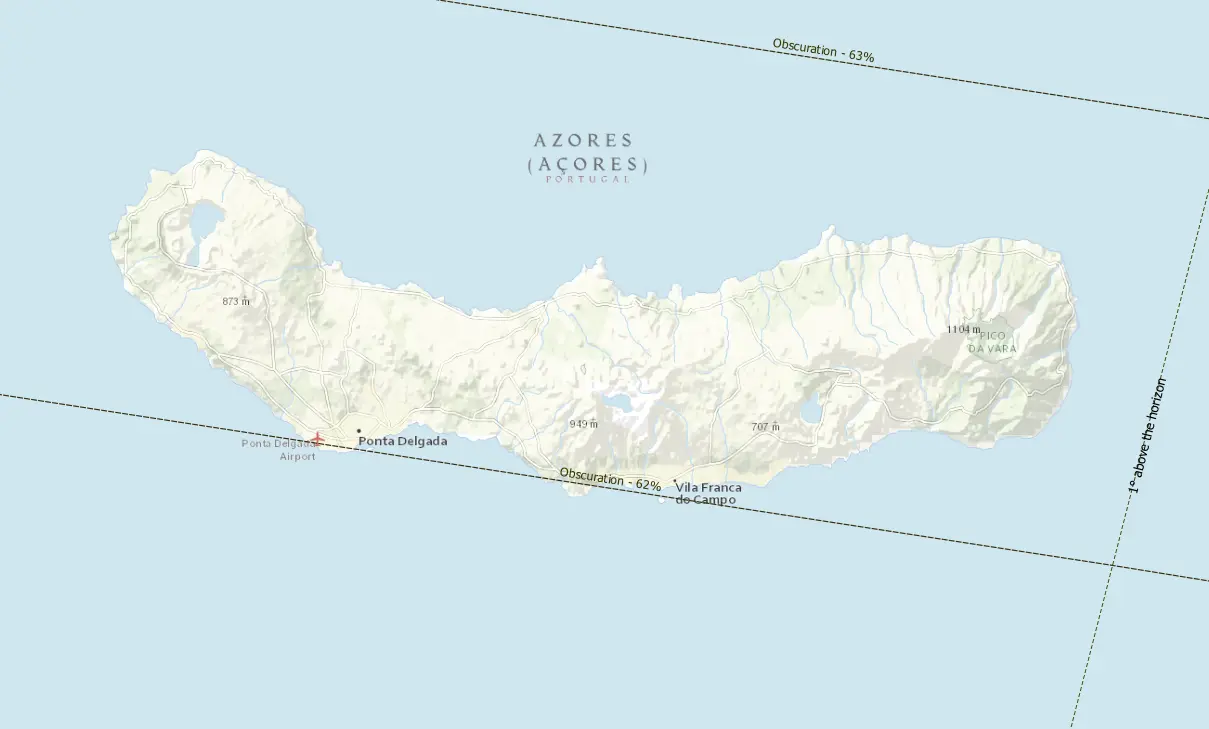
Actually, a better near-sunset view could be achieved from Santa Maria island, where the maximum of the eclipse will occur just a tad before sunset with the altitude of our mother star just barely 1° above the horizon. Unfortunately on this island, the obscuration will be the smallest, just 59%.
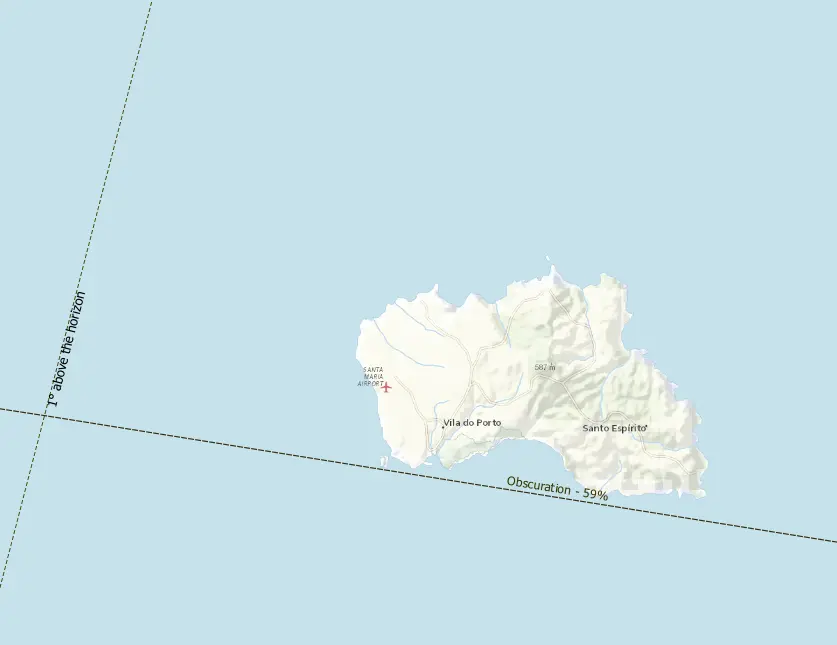
As we go west, the greatest eclipse is to be visible higher above the horizon. An interesting observation venue can be the highest mountain of all the islands, which is both the highest mountain and volcano. The Pico Mountain rises roughly 2351 m.a.s.l and offers a great view of surrounding areas. Looking north, towards the path of totality, the observer could see the water surface at a distance of about 180km, where the obscuration at the greatest phase exceeds 70%. Looking west, the observer can try to spot the remote hills of the Island of Flores at an amazing distance of about 270km when the atmosphere is clear enough.

The Ilha das Flores as well as another one – the Caldeirao enclose the Azores archipelago from the west. These are the only ones, where the greatest eclipse occurs before the golden hour period. The Sun’s altitude will be about 7° above the horizon since the golden hour is considered for altitude 6° and lower. On the other hand, the partial phase at Caldeirao will be the deepest, reaching 68% in obscuration.
If you wish to experience the partial solar eclipse in Europe on April 8, 2024, then the Azores will be the best. The coincidence of quite a deep partial phase with the near-sunset conditions will give the chance to watch both the Devil’s horns just right above the Ocean surface as well as the evening sky, which should be reddish than usual. I am looking forward to some eclipse reports from this area.
2.6 Spain & Portugal
Just a little bit of 2024 partiality can be observed at the north-western corner of the Iberian Peninsula. At western Galician shores, the greatest observed obscuration will be just 3-4%. The small cavity in the solar disk at sunset should be visible in Santiago de Compostela and La Coruna towns.
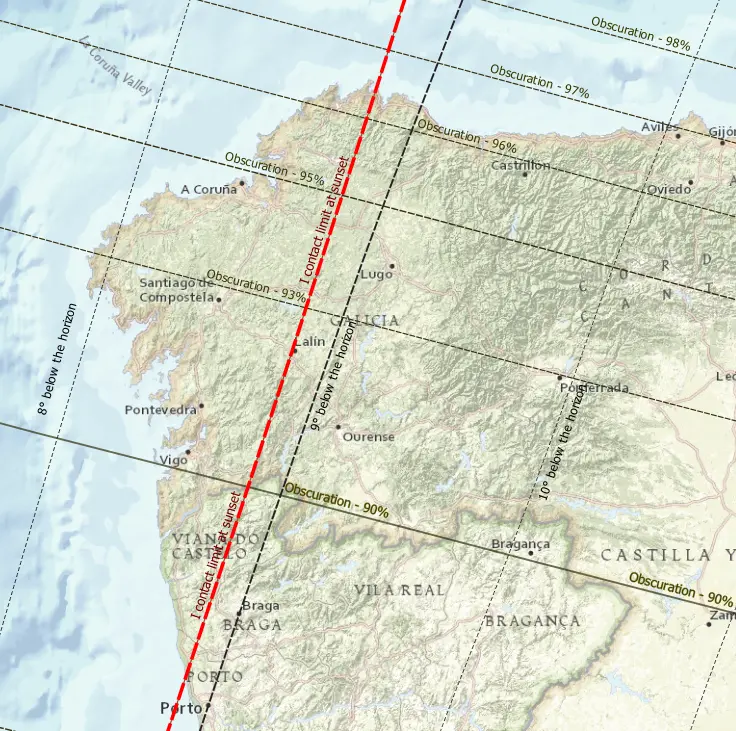
The northern region of Portugal could spot the very beginning of the partial phase around Viana do Castelo surroundings. In fact, when the atmospheric refraction is taken into account, the Ist contact limit can be marked at the line of Braga to Porto or even down to Lisboa region, where the sunset could be watched from the surrounding hills. However, I doubt that anyone could spot anything eclipse-related on the solar disk. In both cases we should be aware, that the lunar disk approaches from the west, so any cavity observed at the solar disk will be visible from the bottom (when standing and looking at approaching sunset). The situation is better explained in the image below (Meeus)
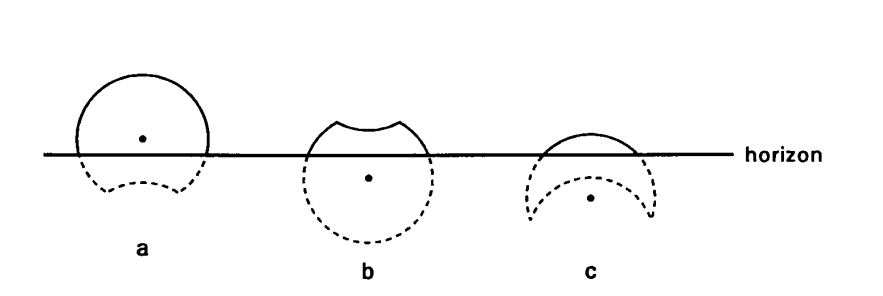
The situation for northwestern Spain and Portugal refers to point a (Pic. 17), where the eclipse processes from the bottom of the image. Image yourself standing a front of the setting Sun, which is about to reach its first contact. Simplifying, the umbra goes from west to east and so penumbra does. Therefore always the lunar limb will start to cover the solar limb from the bottom as far as the near-sunset moment is concerned.
In conclusion, I wouldn’t expect the beginning of the partial phase visible even at the first contact limit.
Much better chances for chasing the beginning partial phase of the eclipse will be at Central Atlantic, at the easternmost archipelagos of Macaronesia collection. Whereas Madeira is still a geographical part of the European continent, the Canarias belong to Africa. Because of their European character (they are Spanish territories), I decided to include them too.
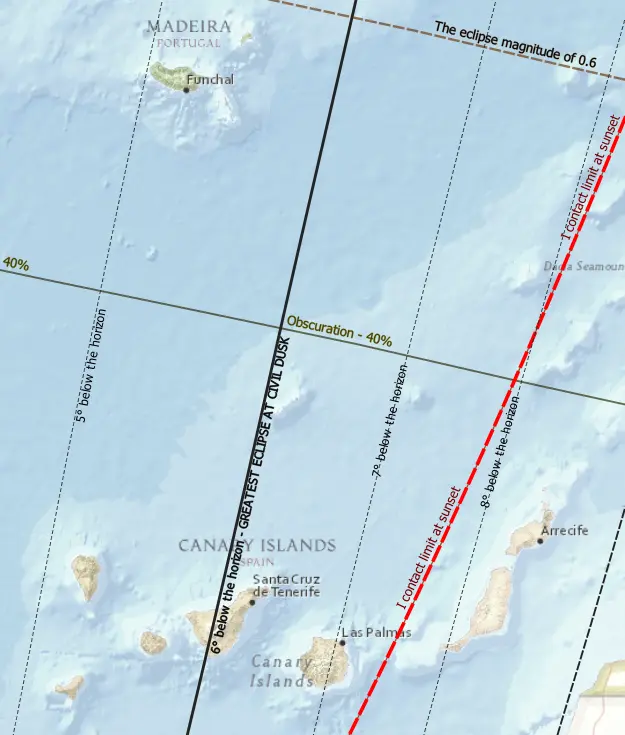
The most from the partiality will take the observers, tourists, and inhabitants of the Madeira archipelago, where the event starts quite early compared to the other areas. They should see at most 20% of obscuration at sunset.
Not all Canary Islands fall within the limit of eclipse visibility. The first contact won’t be visible at Fuerteventura, Lanzarote, and Graciosa islands. I would point out two of the best locations there – the caldera or summit of Mount Teide as well as the La Palma astronomical observatory. The progress of the eclipse will be rather similar to the one observed recently on October 14, 2023.
3. ECLIPSE EVENT BELOW THE HORIZON
The basic pattern of the event looks like in the pictures below. The end of the eclipse will occur at 19:54 UTC. This is the moment of the greatest eclipse phase roughly at the geometrical sunset. Next, the Moon’s shadow goes to space through the atmosphere. Since the greatest eclipse phase occurs at sunset, the same phase will apply to the whole twilight zone, as this is the very last section of the ground touched by the shadow. From this moment shadow can continue just within the atmosphere.
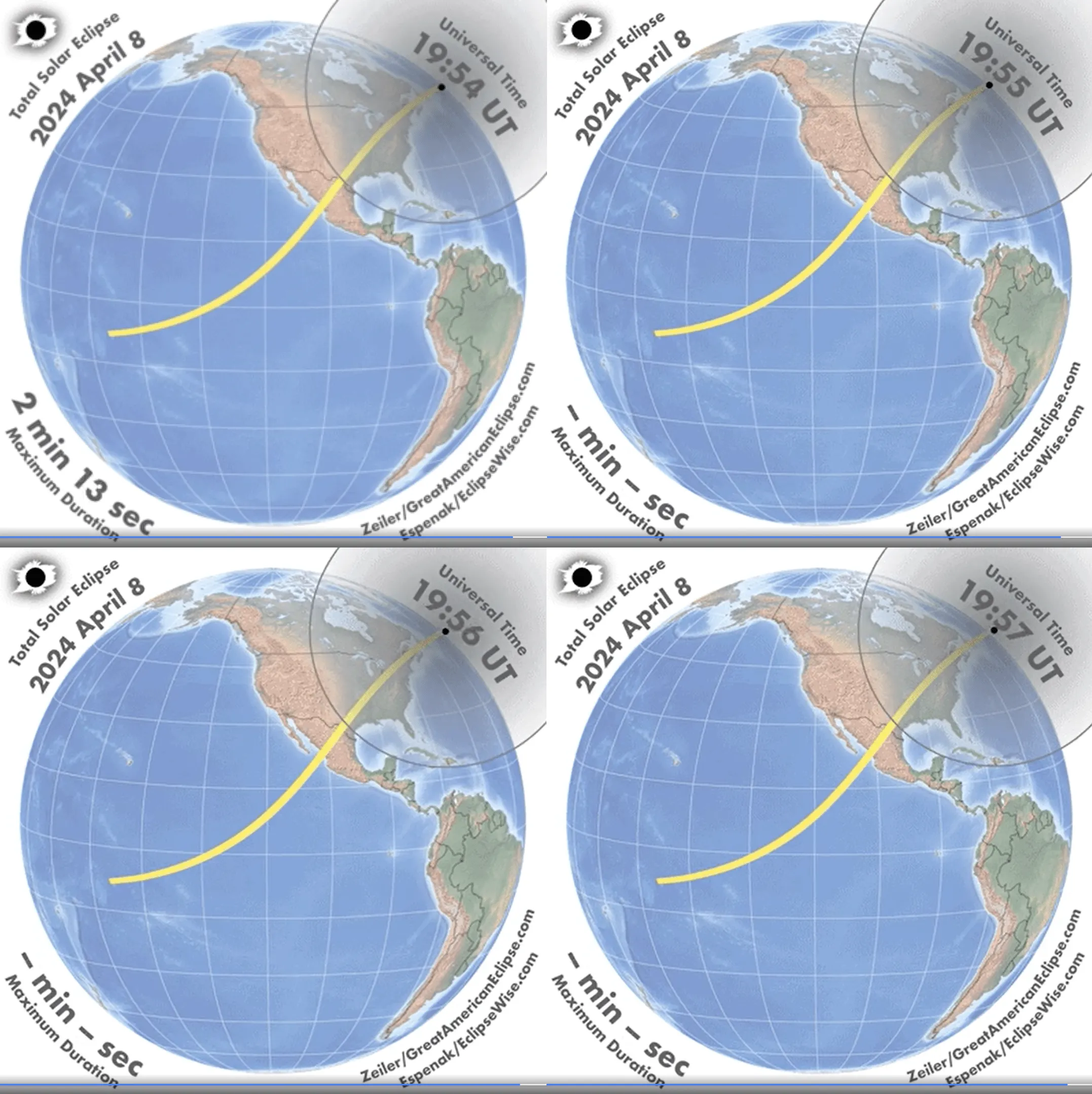
Next, once the umbra leaves the ground it’s still present in the atmosphere for a short period, then goes higher into space. The rough depiction of this phenomenon has been described in this article. When the umbra is definitively gone, there is still penumbra, which keeps affecting the twilight. The deepest penumbra will remain at the extension of the totality in the twilight zone.
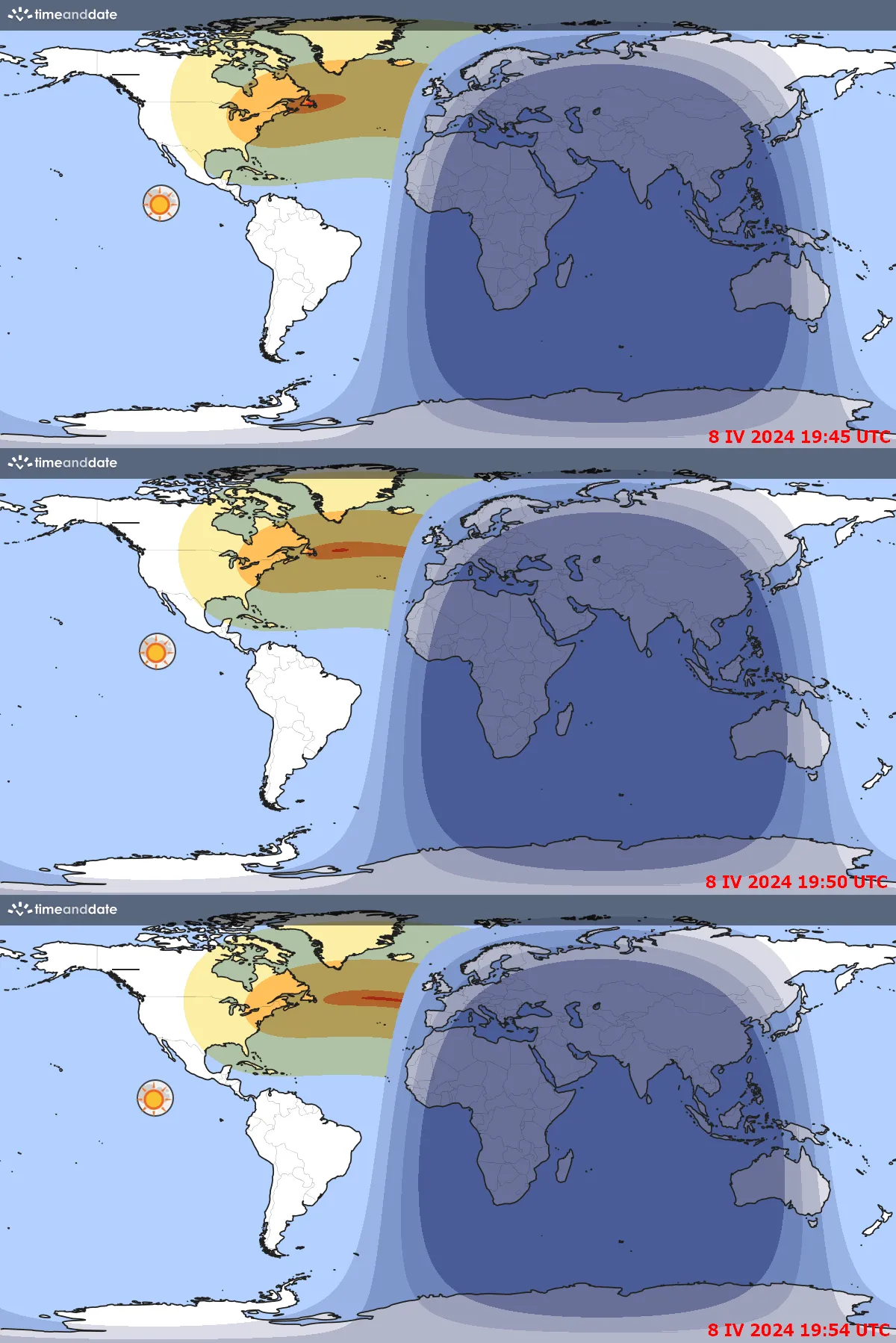
Following Guyliaev’s work (1992), all people will experience the double-shadow phenomenon, in which the Earth is eclipsed both by the Moon and itself, especially when considering the section of the sky falling beyond the Earth’s shadow.
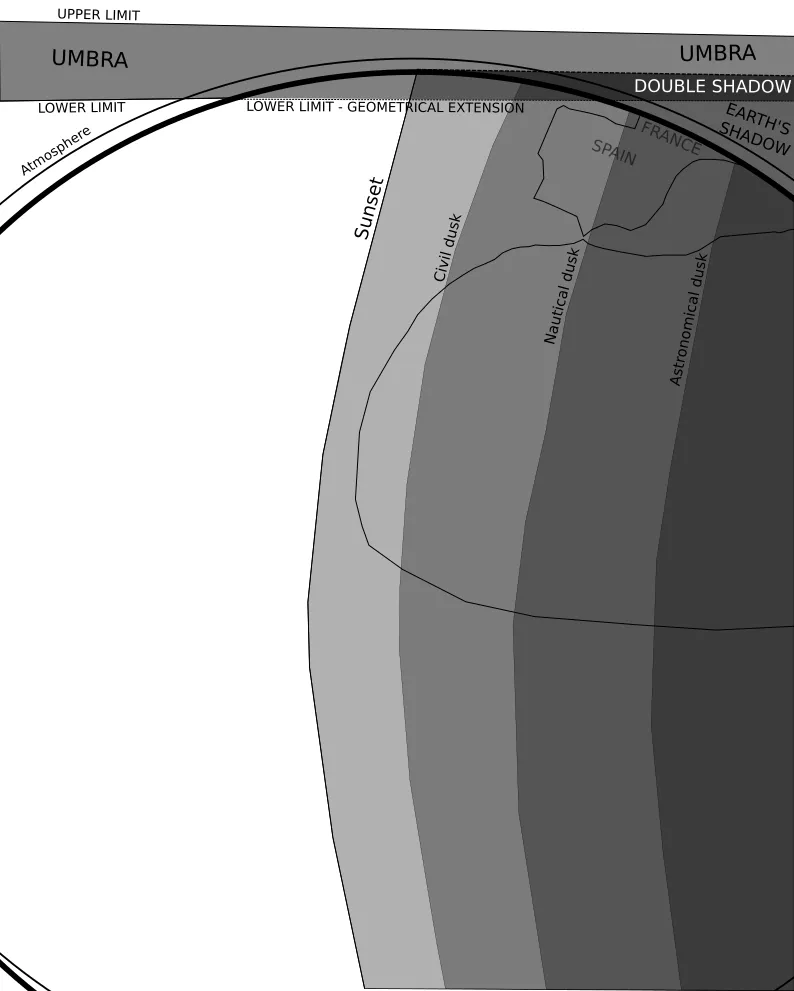
The Earth’s shadow starts to be visible just after the sunset and goes up in the sky reaching its zenith at the end of civil twilight, when divides the sky roughly in half. This is because the ozone layer marks the border of a thicker atmosphere with more air molecules at about 40km above the ground. Next, it keeps going towards the horizon to make the final sky sphere coverage roughly at the end of nautical twilight. That’s why the solar horizon remains quite bright until the solar depression of 12° and is usually noticeable on video records, typical webcams, etc. Next, in fact, the upper Earth’s atmosphere remains illuminated until the end of astronomical twilight, but only the layers with a small amount of air molecules are illuminated, so not much light can be scattered down to lower layers. Therefore the horizon in the solar direction is just slightly illuminated, usually not enough to be recorded without long-exposure photography or high ISO sensitivity.
Because the « totality » below the horizon in continental Europe takes place within the astronomical dusk zone only, the entire sky will be double-shadowed, but long exposure photography or high ISO imaging will be required for documentation of the effect.
3.1 France – a rough extension of the totality
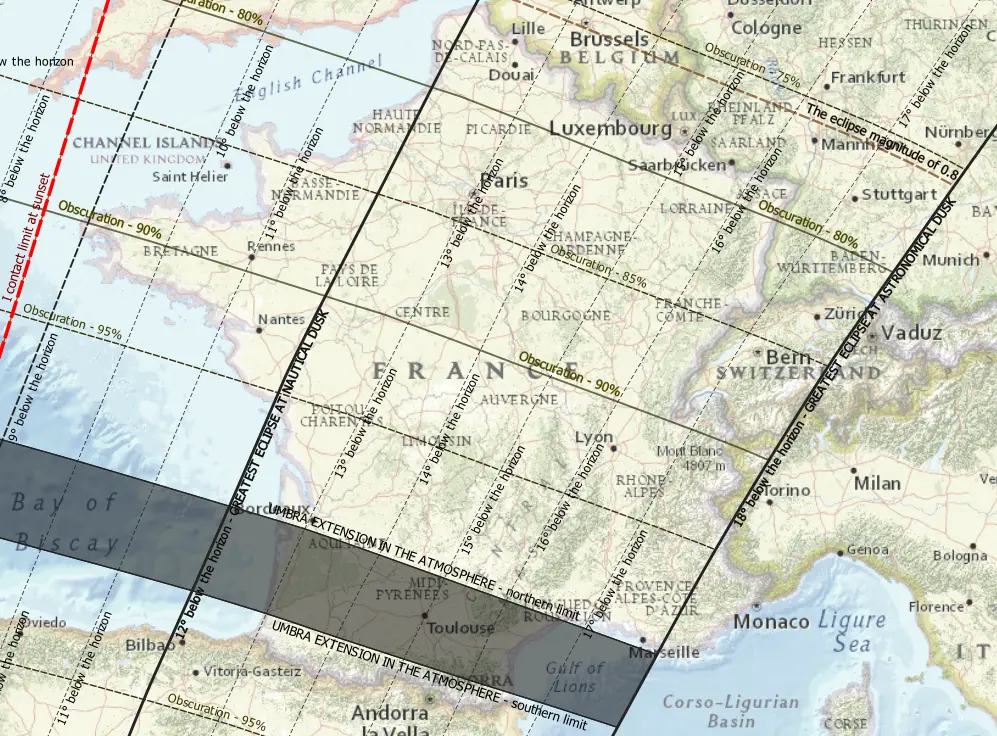
The 2024 solar eclipse won’t be visible above the horizon in France. Even in the westernmost part of the country (The Ouessant (Ushant) Island), the sun goes beneath the horizon just right before the first contact.
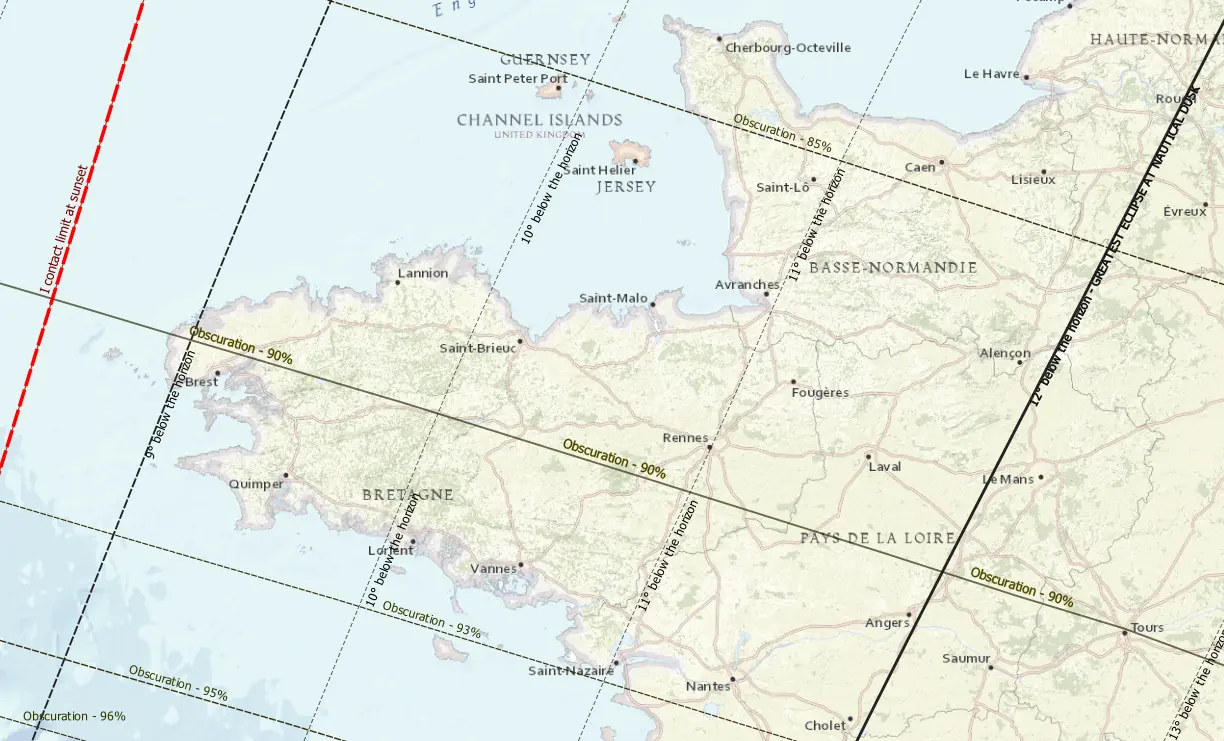
Across the whole country, the greatest eclipse occurs below the horizon. The western shores should experience the event by late nautical dusk. Predominantly just astronomical twilight will be affected making this celestial event barely or even unnoticeable for casual observers because of high light pollution across the country (see the later chapter). The twilight at Cote d’Azur will proceed almost as normal. The eclipse will reach a deep magnitude at the end of astronomical twilight, but the culmination of the event will happen for solar depression of 18 to 19°.
Undeniably the most interesting is the extension of the totality path, which has been computed roughly across the southern parts of the country.

Sadly, the whole section refers just to astronomical twilight only and terminates southeast of the Gulf of Lions. Absolutely best conditions for potential observation of the event will occur at the Gulf of Biscay shores at Nouvelle-Aquitaine region. At the moment of the event, these places will be right after the beginning of the astronomical twilight. The observers standing on the beach i.e. at the Pilat Dune should be able to see some faintly illuminated sections of the western sky, which at the moment of totality will be divided with the dark swath.
I wouldn’t expect something valuable going further along the Spanish border because of deeper solar depression and significant light pollution.
An interesting region for casual eclipse twilight observation is the Pyrenees range. These mountains stretch almost parallelly against the extension of totality and expected obscuration for the Sun from that place is calculated between 98 and 99%. The mountain hikers, climbers, and other people will definitely find some elevated venues with the horizon open westwards. Despite a slightly lower level of light pollution, the glow of cities located nearby will definitely disturb the observation.
3.2 Galicia – the best region for watching the 2024 solar eclipse below the horizon
The Iberian Peninsula is divided almost by half between the nautical and astronomical dusk as the greatest phase of the eclipse is concerned.
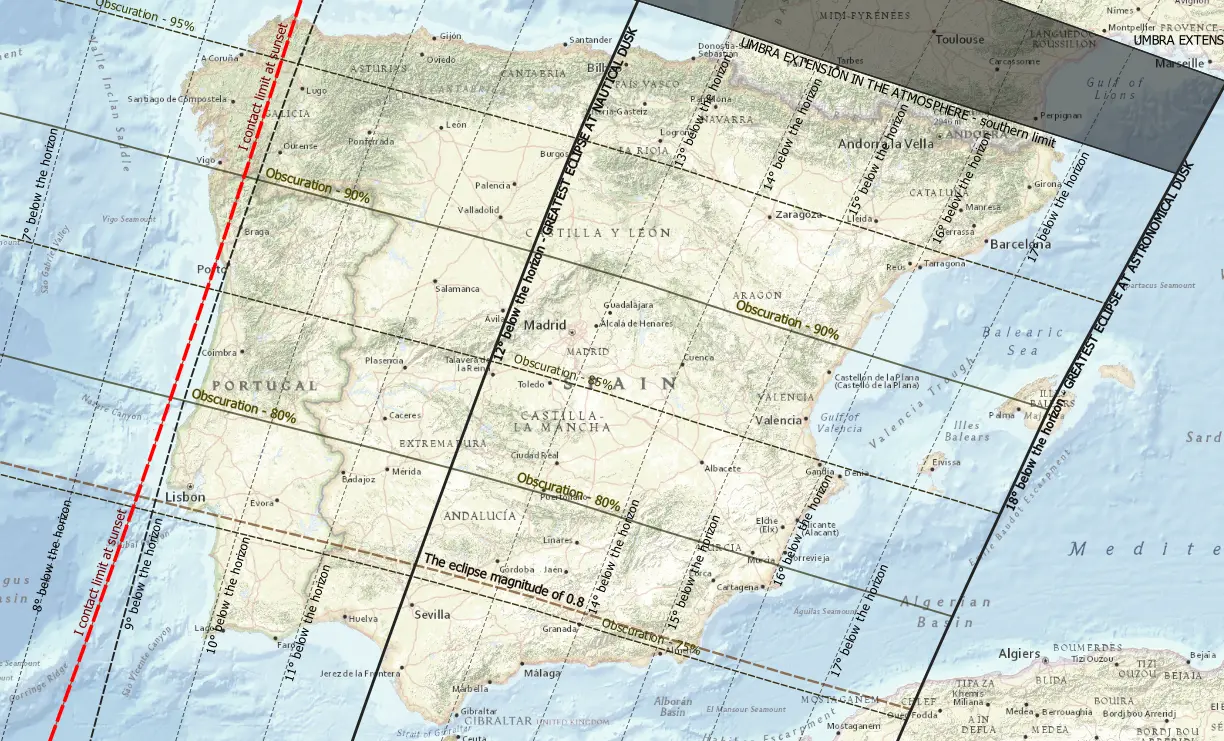
The northwestern corner falls within the limit of visibility in the partial phase after the very beginning. It was discussed in the earlier chapter. Considering the greatest phase, the best conditions for the observation will apply just to the Galicia region located in the northwestern part of Spain. This area will be probably the best for watching the 2024 solar eclipse below the horizon. The greatest phase with obscuration exceeding 96% will occur in the mid-nautical dusk. Obviously, the observer can locate himself in the Asturias Mountains and use the favorable horizon dip when looking northwards. The solar depression will be about 10° there.
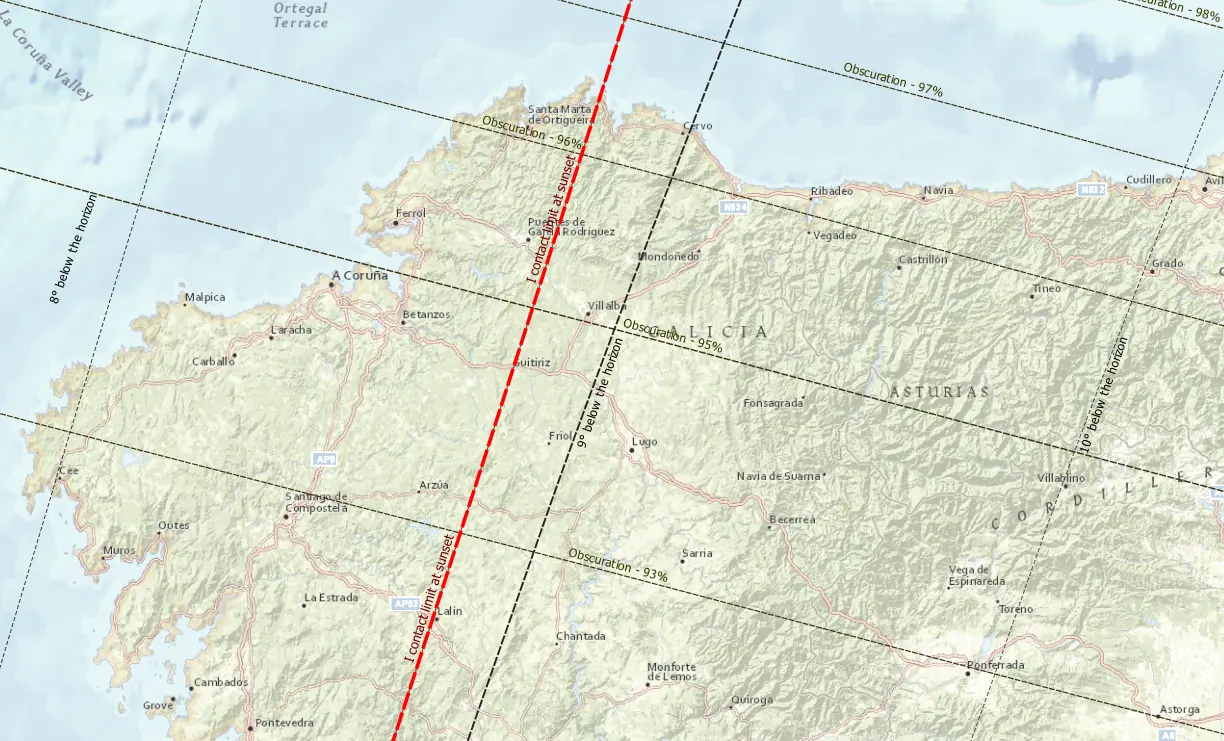
Considering the locations easily accessible by plane or ferry, we could consider Santander or alternatively Bilbao. Because the distance from the nearest airport to the remote Galician locations can exceed 600km, coastal cities like Santander seem to be good enough. Unfortunately the greatest phase, despite the almost-total conditions with 98% obscuration will occur before the astronomical twilight (11° below the horizon).
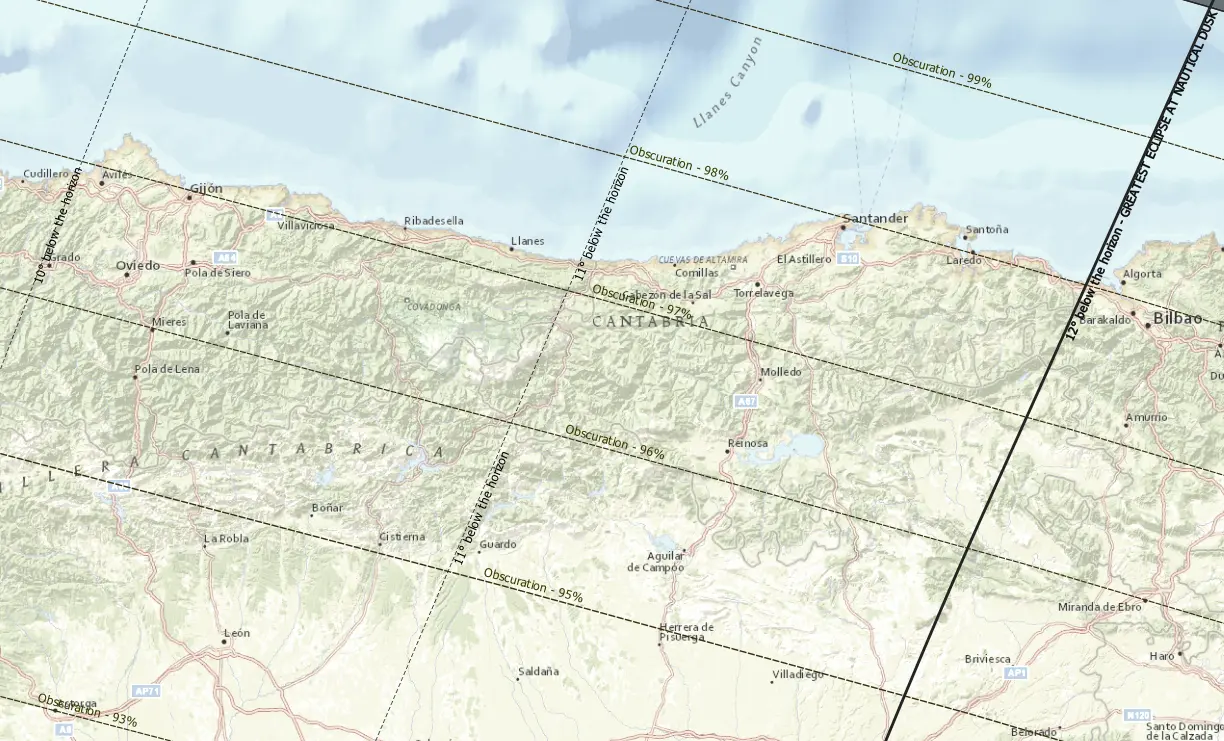
The circumstances computed for Bilbao indicate the end of nautical twilight for the greatest phase.
An interesting area for watching the eclipse event below the horizon can be the mountainous region of the Pyrenees. In Andora for example, the eclipse obscuration is computed at over 98%, but the thing will happen at a solar depression of 16°.
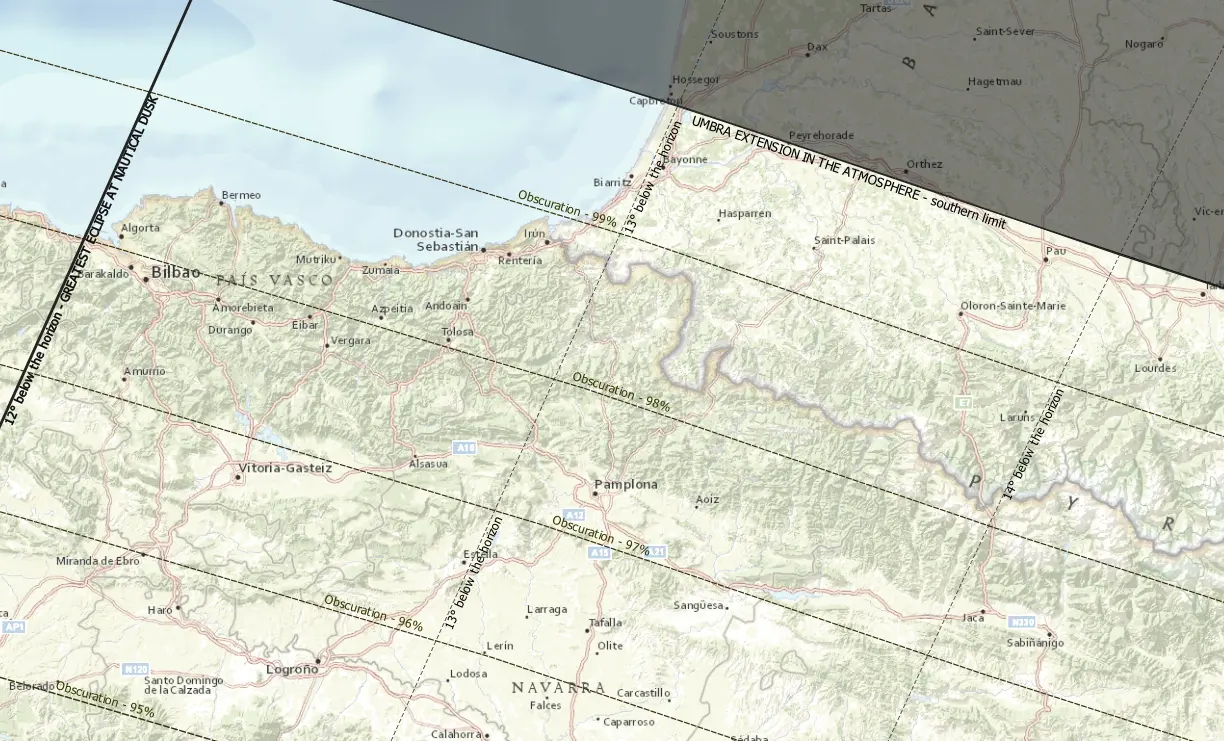
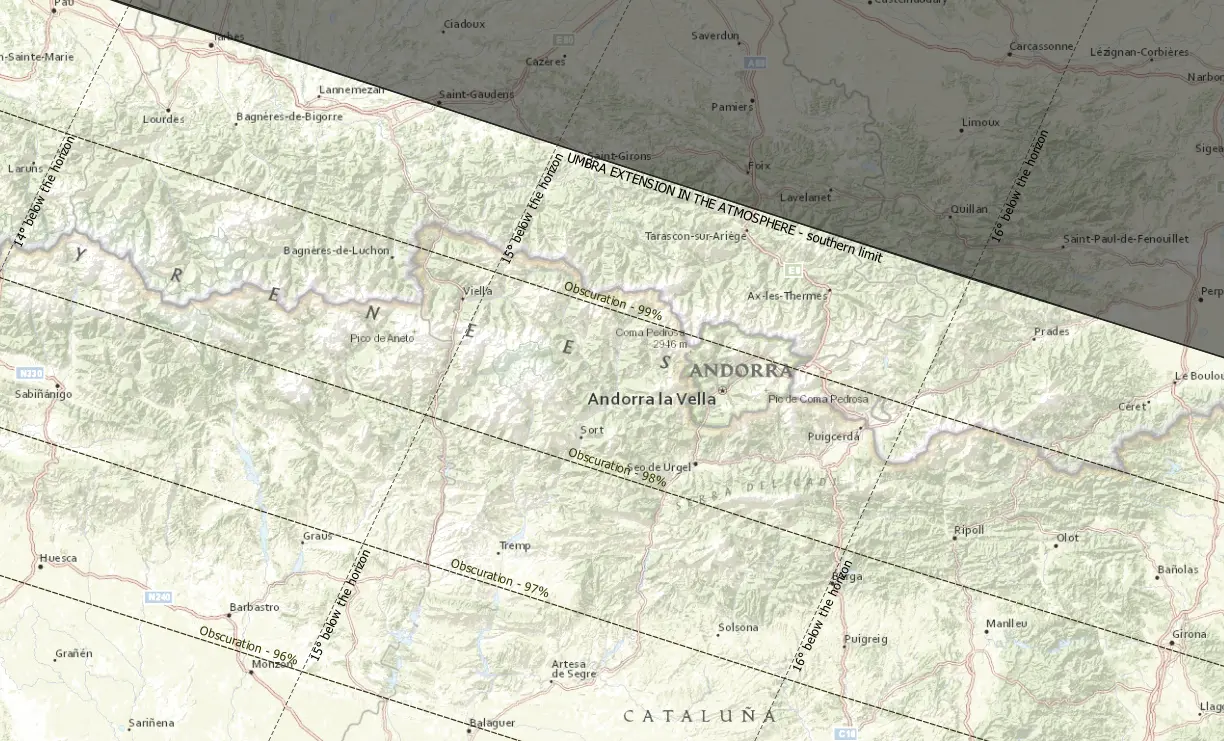

The northeastern Spain almost reaches the totality extension, although just for late astronomical twilight, which probably won’t be noticeable.
3.3 UK & Ireland – significant darkening and twilight standstill phenomenon
As it has been told earlier, two-thirds of the UK will see the beginning of the partial phase. However, the culmination point will be definitely the greatest phase occurrence near the end of civil dusk in Ireland and at mid-nautical dusk in Great Britain.
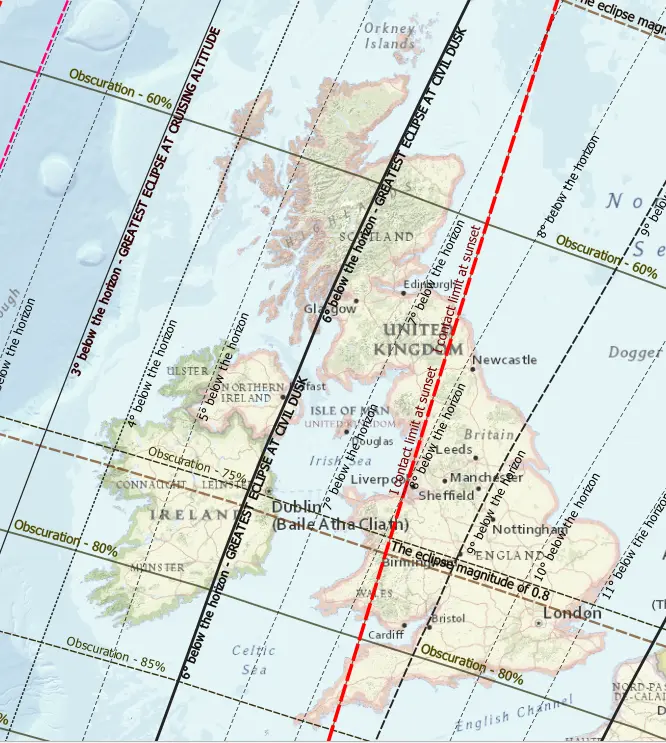
There are areas with significant eclipse magnitude, which exceeds 0.8. It corresponds to the obscuration of 75% pretty much. It’s enough magnitude for the twilight standstill occurrence as the dusk will be considerably affected.
In Ireland, the greatest obscuration, over 80% will be observed at late civil dusk in the southwestern part of the country. There is the highest mountain in the country – Carrauntoohill, rising 1084 meters above sea level, which is located at the Iveragh Peninsula. It can be a nice venue for the eclipsed dusk observation.
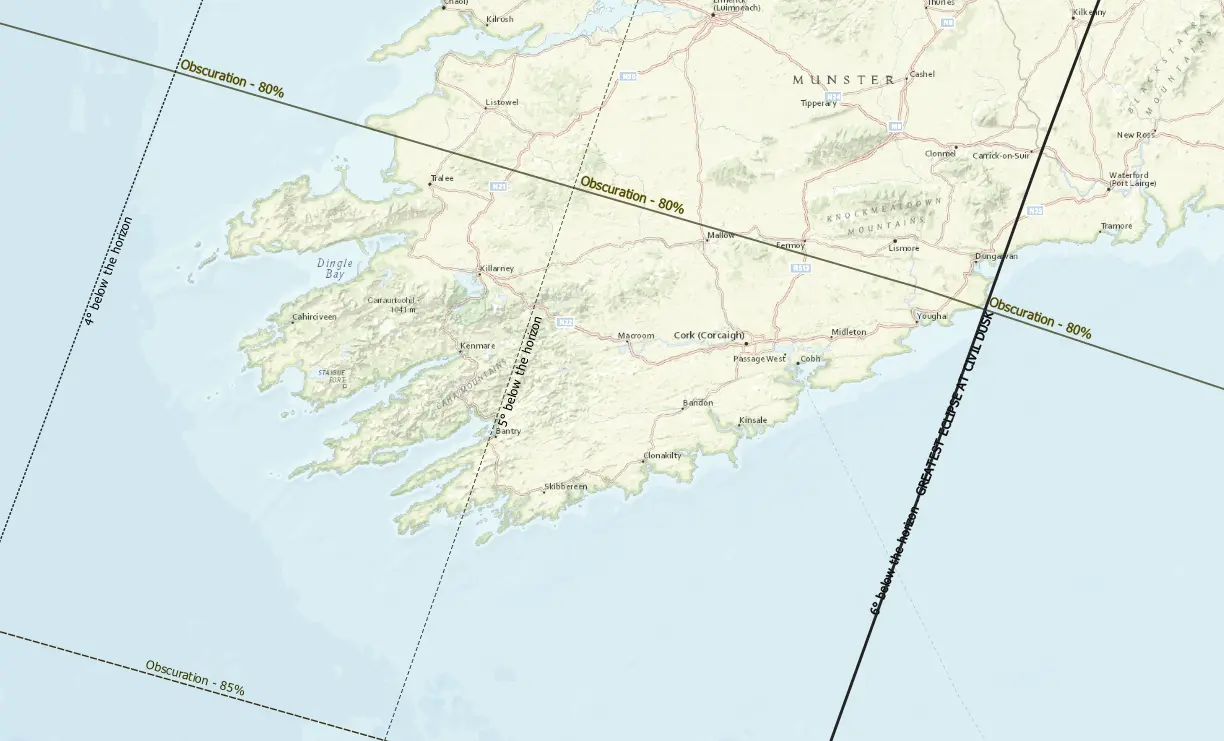
A slightly deeper phase should people expected in the southwestern part of Great Britain, where the obscuration will be higher than 85%. These conditions I would point out as the second most favorable after northern Spain. The greatest phase will be observed at mid-nautical twilight except for the Isles of Scilly, which should experience the event at the solar depression of 7°.
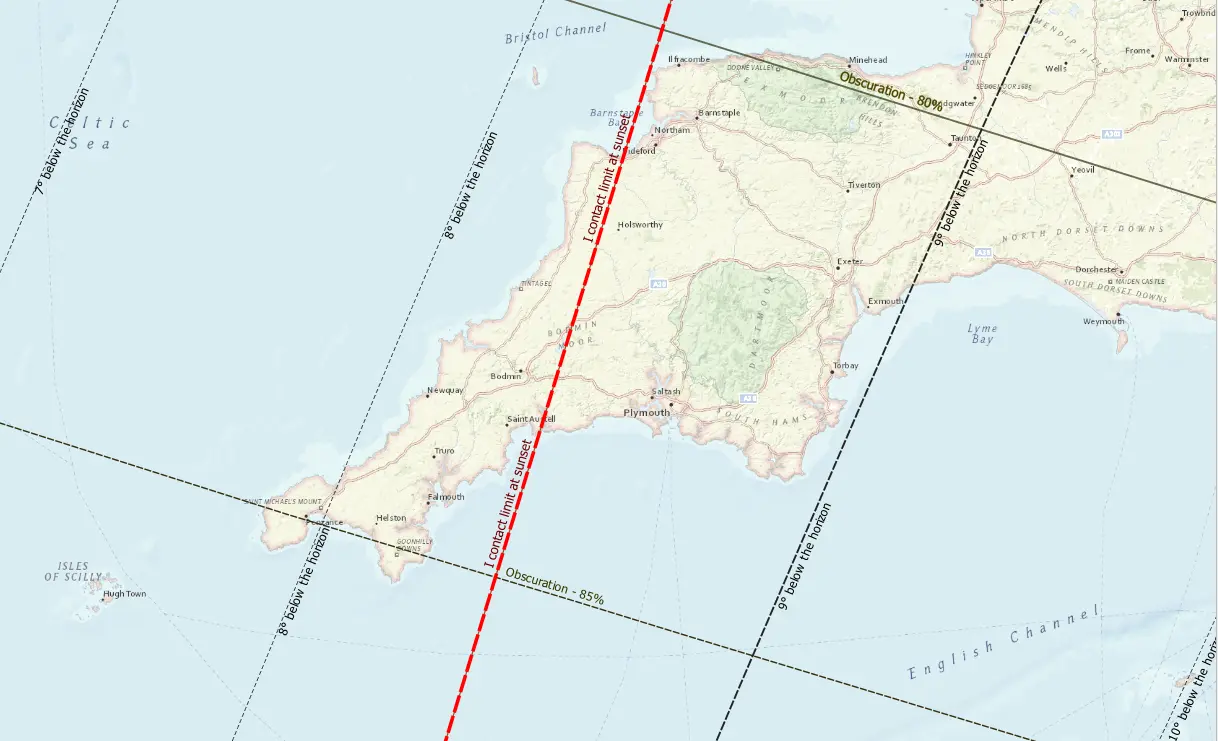
The obscuration of 87% can be gained from the Isles of Scilly, which will be the best location for enjoying the solar eclipse below the horizon event. In fact, the same eclipse magnitude will occur at the Channel Islands, but at late nautical dusk with a solar depression of 10°.
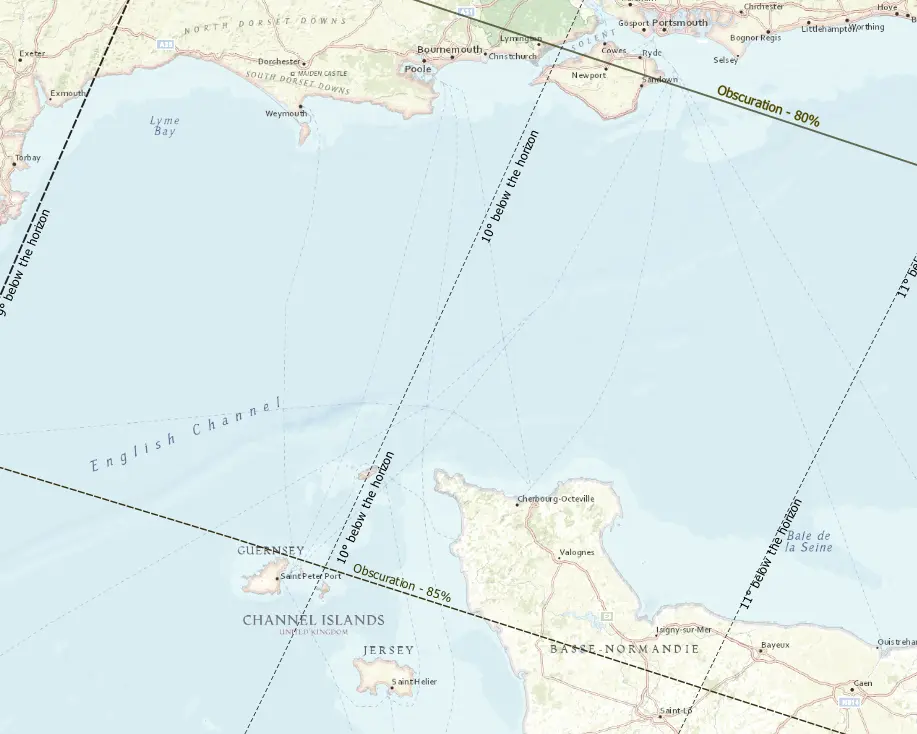
3.4 Other areas
FAROE ISLANDS
The whole archipelago will see almost half of the partial eclipse, which is discussed in the previous chapter. However, the greatest eclipse will be barely missed as the sunset occurs just a couple of minutes earlier. The greatest phase with obscuration between 46 and 48% will occur at the beginning of civil dusk with a solar depression of just 2°, so it should be easily visible from all the planes flying above the archipelago.
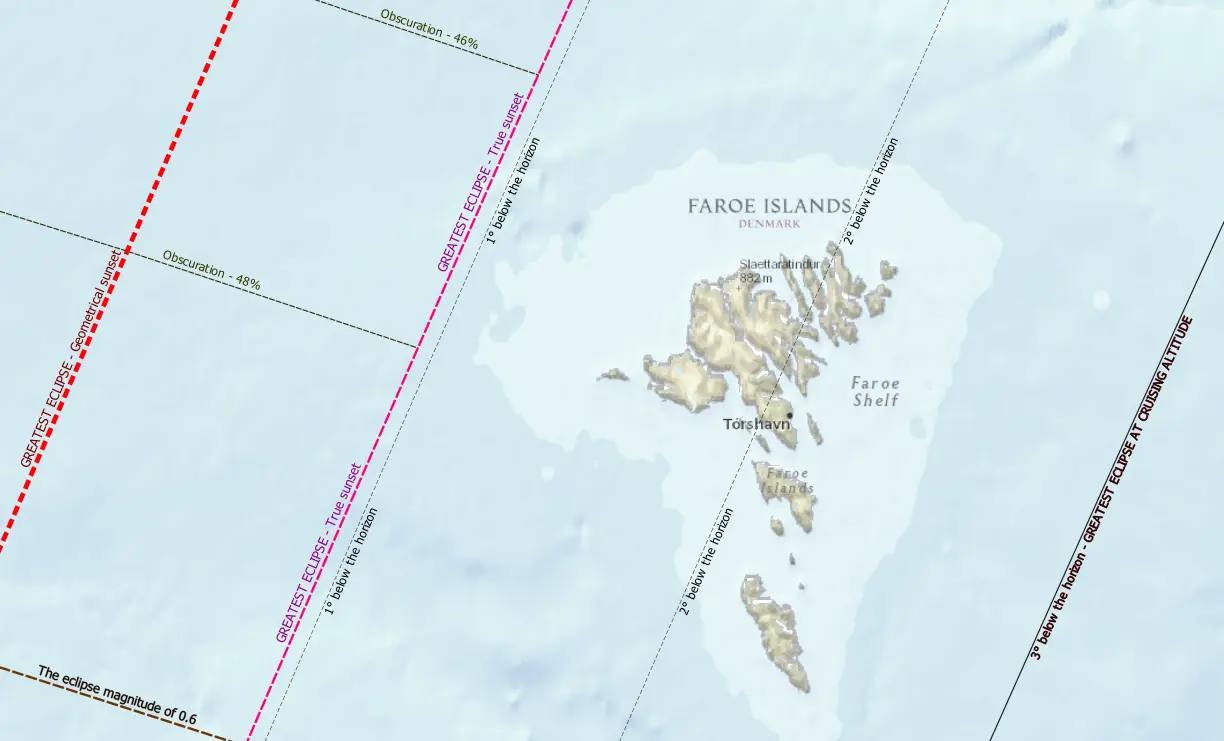
SCANDINAVIA & DENMARK
The whole Scandinavian peninsula will experience dusk disturbed by the partial phase of the eclipse, where approximately half of the area falls inside the nautical twilight zone. The northwesternmost pieces of Noway (i.e. Lofoten archipelago) will be affected by the greatest phase at an early stage of nautical twilight with solar depression at just 7°. On the opposite side, where Helsinki is located, the event will be rather unnoticeable, because takes place just before the end of astronomical dusk.
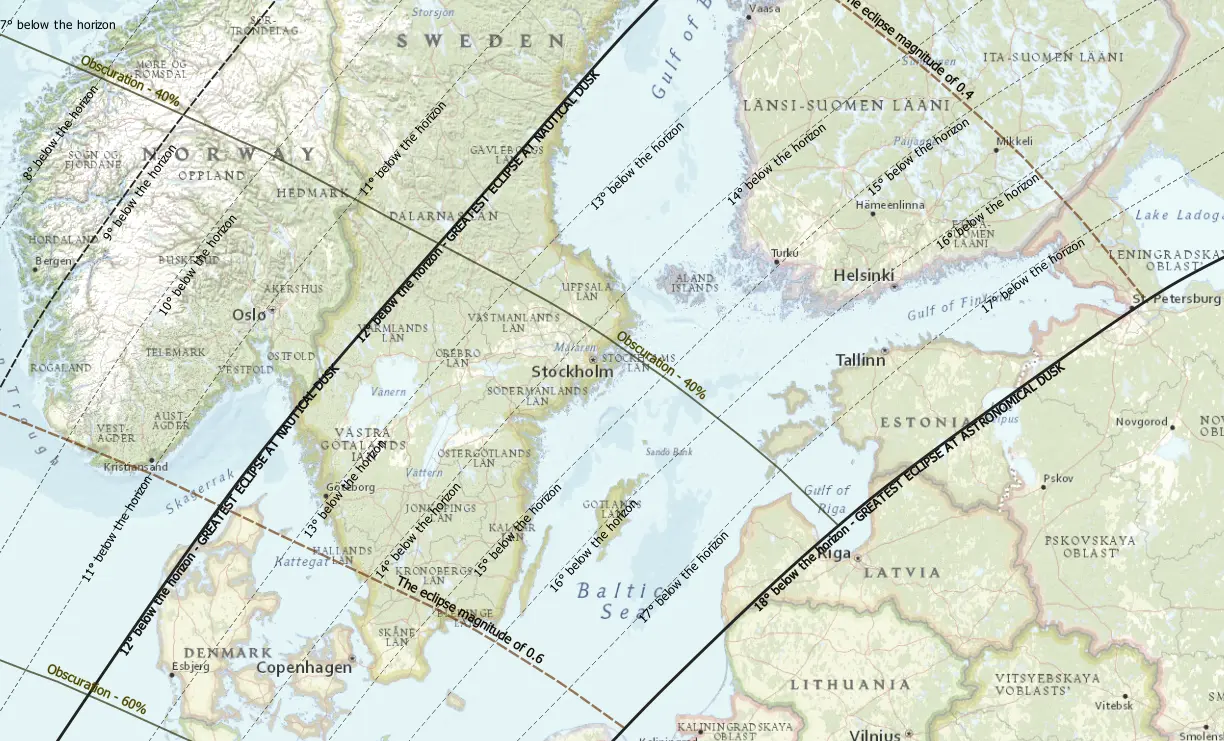
As far as the eclipse magnitude is concerned, the biggest twilight disturbance should be noticed at the southwestern coasts of the peninsula, especially within Norwegian borders, where the event culminates before the end of nautical twilight.
Denmark’s mainland will get the eclipse maximum roughly at the beginning of astronomical with obscuration hovering at nearly 60%.
POLAND
Just the northwestern part of Poland will be within the astronomical dusk at the moment of the greatest eclipse with obscuration of approximately 60%. The event probably won’t be noticeable by casual people.
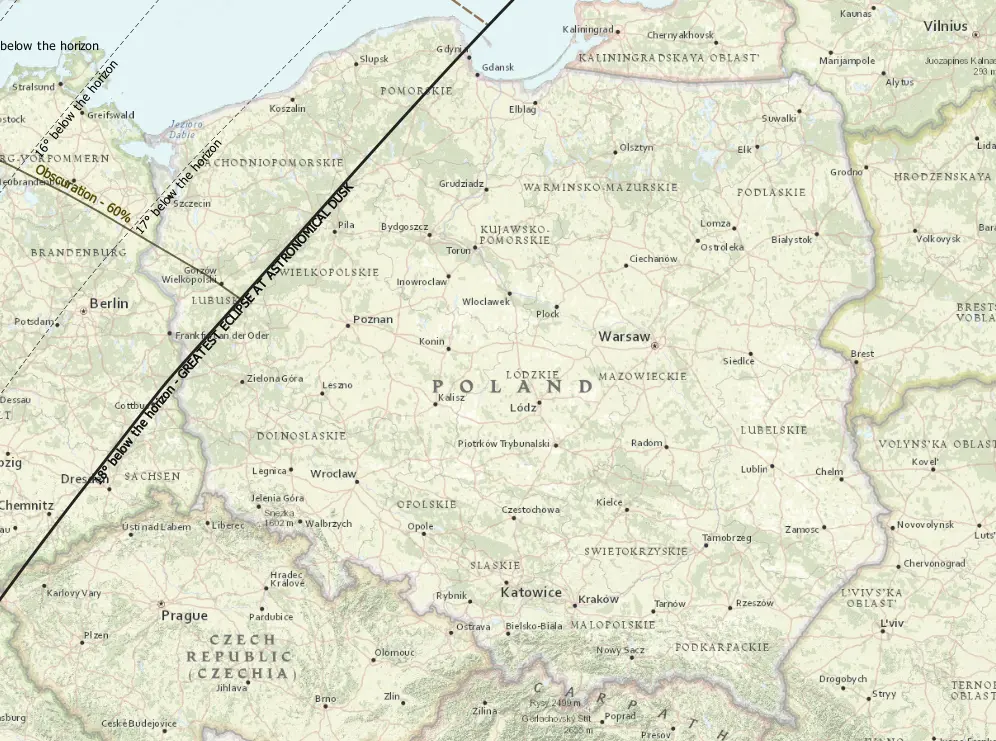
GERMANY & BENELUX
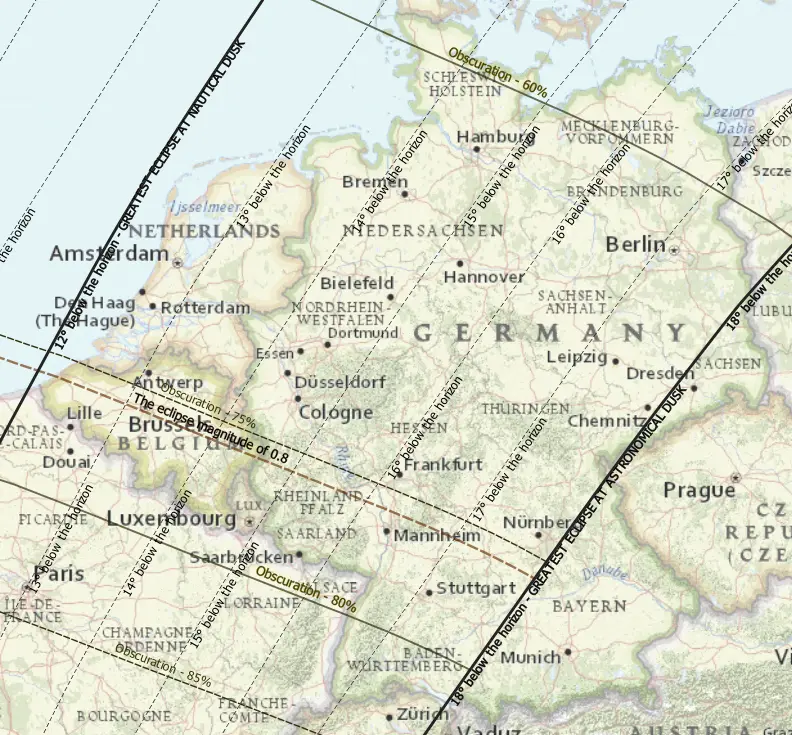
The 2024 solar eclipse below the horizon in Germany will affect the astronomical dusk only and the tail end of the nautical one just at the North Sea shores shortly before the greatest phase. Considering the obscuration at the greatest phase it will change from less than 60% in Western Pomerania to more than 80% in the Baden-Wurttemberg region.
The Benelux countries will catch the greatest phase at an earlier stage of the nautical and astronomical dusk. From the Belgian and Dutch seasides, the eclipse’s impact on twilight should be noticeable, as the greatest phase occurs just at the very beginning of astronomical dusk when the sky remains still illuminated above the horizon in solar direction.
SWITZERLAND & ITALY
Despite of significant solar depression at the moment of the greatest eclipse Switzerland should be fairly considered as the observation venue because of mountainous areas. This country located at the chain of Alps offers a lot of elevated and well-placed locations with a clear western horizon. Not to mention, that the air quality is usually much better above the planetary boundary layer where most of the mist and haze is trapped. These particles are also able to block artificial outdoor light, therefore the light pollution should dwindle. Another advantage of being at the top of the Alps is the horizon dip. When the observer stands at the Monte Rosa summit, he will gain more than a 2° dip of the horizon. Since the greatest eclipse at the location of Monte Rosa will occur at a solar depression of almost 18° in practice it will be less than 16°. Theoretically, this location marks almost the end of the dusk at the moment of the eclipse culmination, but with the horizon dip an observer could notice that the sky glow at the western horizon is too faint.
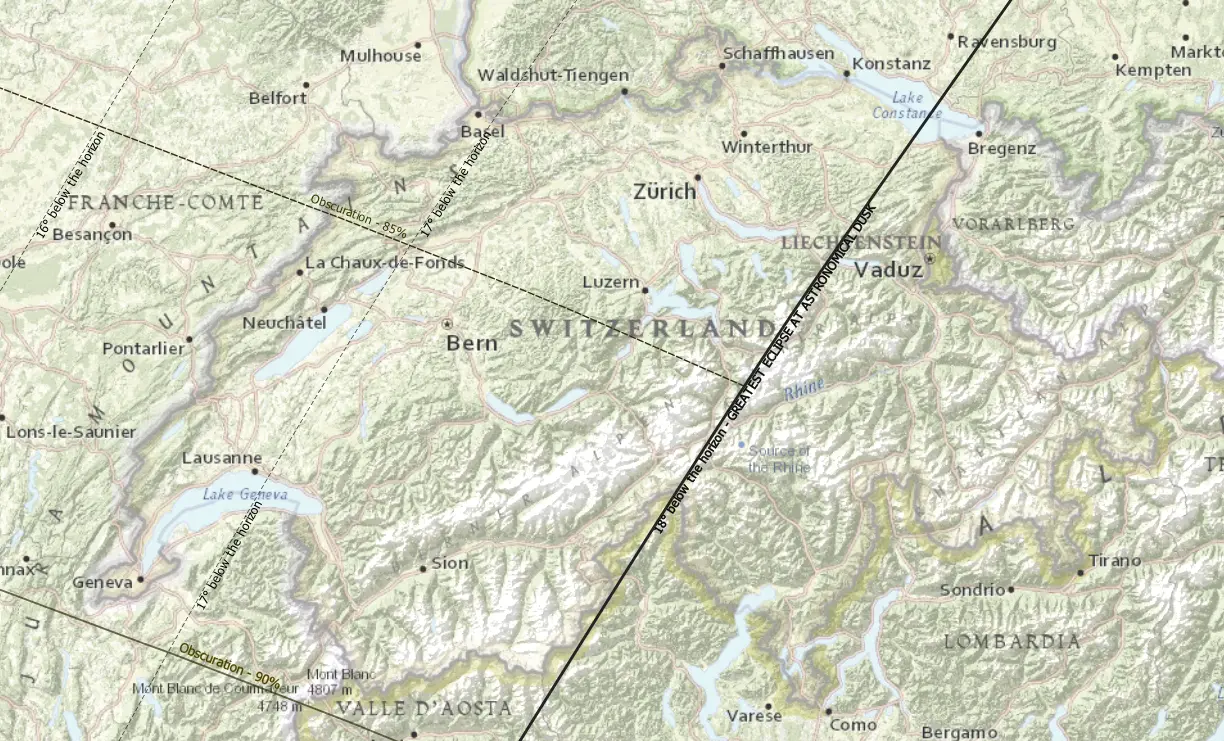
PORTUGAL
Portugal is the westernmost country of continental Europe and the one of a few, whose inhabitants will see a bit of partial phase right after beginning. Considering the circumstances below the horizon, the greatest phase will occur at late nautical twilight. The North region should experience the most appreciable impact with obscuration exceeding 90%. This is almost exactly the same region, where 2 years later the 2026 totality will take place. The southernmost region Alentejo will experience the obscuration of about 75%.
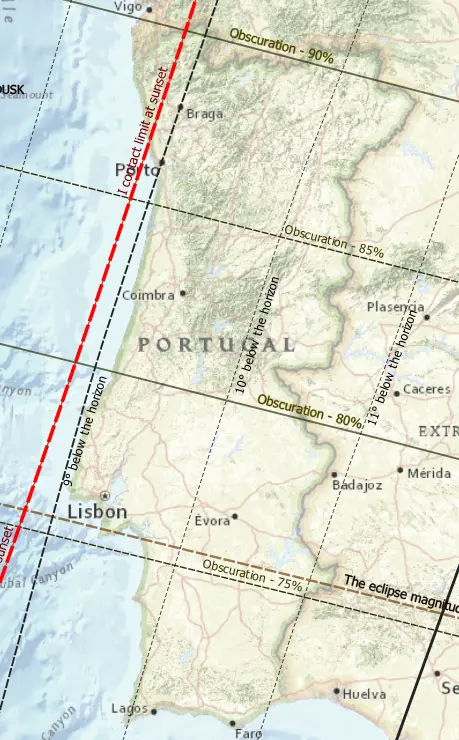
4. 12P/PONS-BROOKS COMET OBSERVATION
The 12P/Pons-Brooks is a Halley-type comet, which visits the Sun’s neighbourhood every 70,5 years. The last time the comet was visible close to the Sun was in the year 1954. The same as previously, the visibility conditions are unfavorable, because the 12P/Pons-Brooks perihelion is on the opposite side of the Sun. The estimated magnitude of the object is +4.71Mag on the day of the 2024 total solar eclipse. The object brightness is estimated to be very similar to the Tegmine (ζ Cancri) star. In fact, some short peaks of brightness can occur, but nobody knows when.
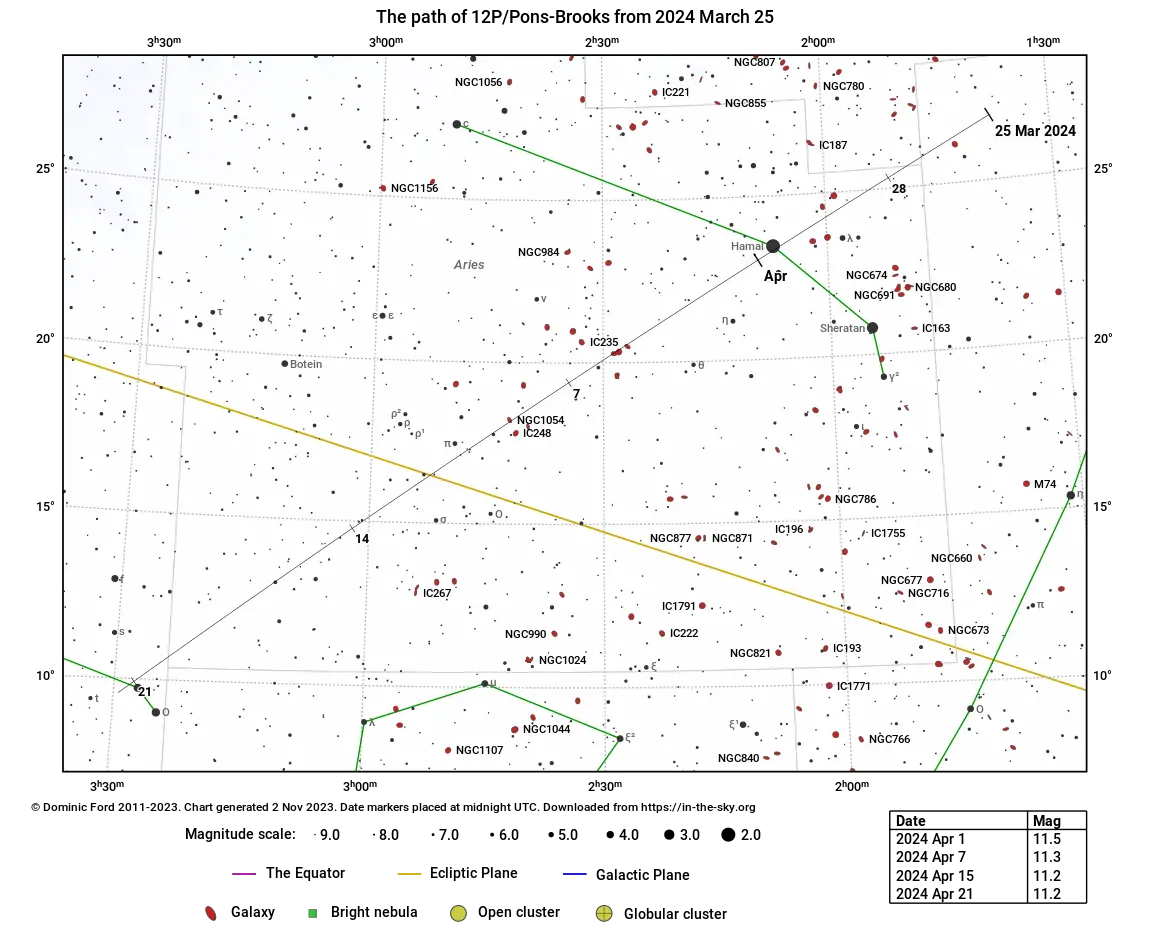
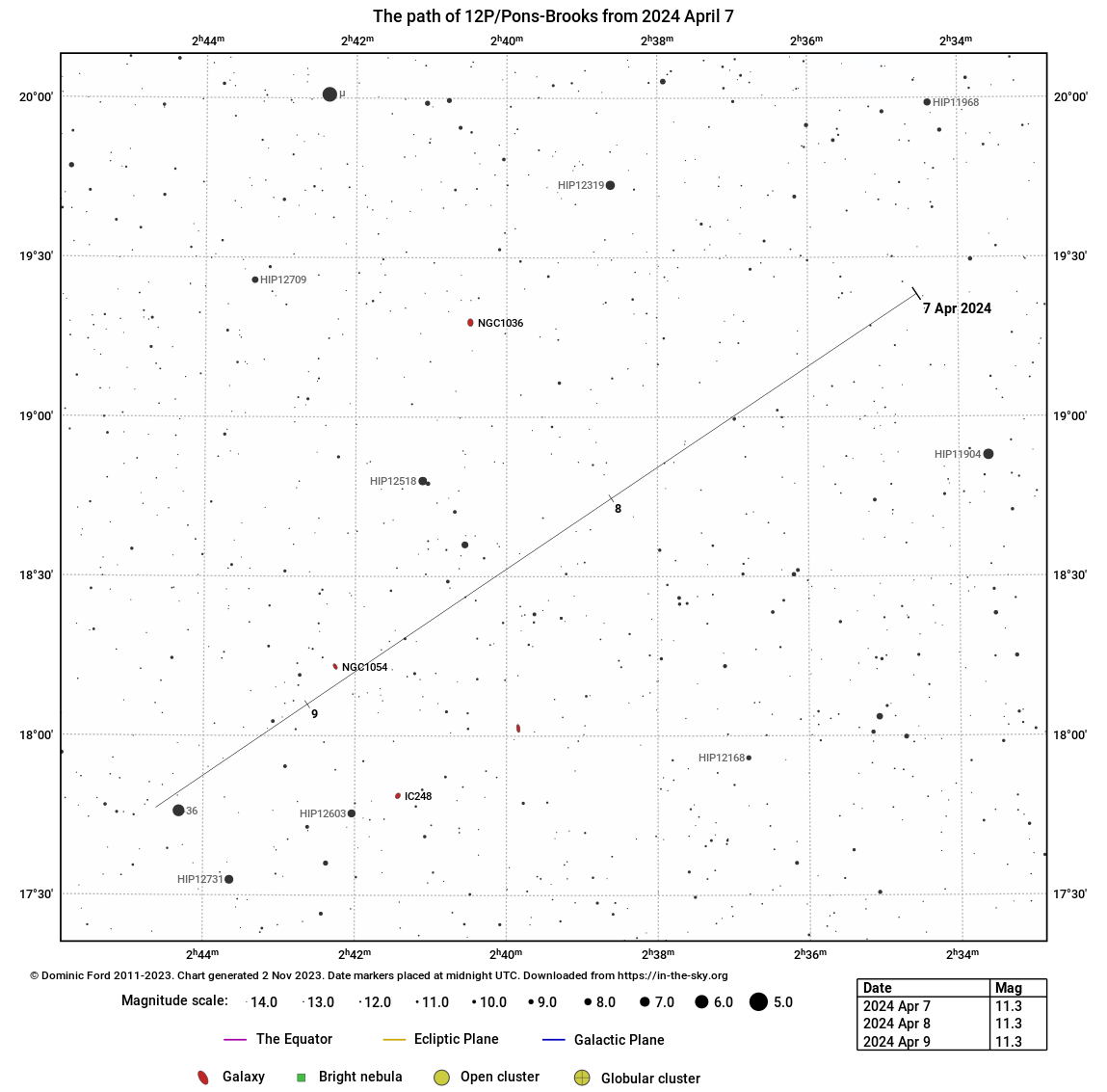
In conditions such as this, the comet will remain unnoticeable during the 2024 total solar eclipse as far as the naked eye is concerned. Obviously, you won’t agree with me when using some telephoto lens or some HDR imaging techniques, etc. I am considering someone, who uses just his eyes or a very basic approach with photography.
Even if observers will handle capturing the 12P/Pons-Brooks comet during the 2024 totality there is no doubt, that the best observation window over the entire period of its presence near perihelion will fall at the moment of the totality, of course, but below the horizon when the sky will be much less illuminated by the scattered light than during visible totality. Since the total solar eclipse gives conditions similar to the end of civil twilight, the same totality at the solar depression adequate to the beginning of astronomical twilight should eliminate the scattered light totally. Of course, you would say, that the comet will be visible after the end of astronomical dusk and you will be right. The problem is in the celestial altitude of the object, which will be lower. The chart below shows how things stand in this matter.

At the moment of the greatest eclipse phase, the altitude of the 12P/Pons-Brooks comet is about 10° above the horizon, whereas at the end of astronomical dusk, it decreases to just 4° above the horizon. For altitude such as this, the object is less visible due to atmospheric extinction. A matter such as this has been discussed widely in this article. Another thing is, that despite the perihelion, which the 12P/Pons-Brooks will pass on April 25 the conditions of object visibility will be worse in the northern hemisphere. This is because the day gets longer and the twilight period either does. On April 8 the declination of the 12P/Pons-Brooks comet is +18°44’40 » and the object moves southward in the sky. On the day of perihelion its declination is +07°05’07 » placing it in Taurus, still in the northern celestial hemisphere. Solar declination changes between these 2 dates from +07°18’26 » (April 8) to +13°16’55 » (April 25), but the solar separation decreases at the same time from 25° (April 8) to just 23,2° (April 25). It means, that in equatorial latitudes, at the end of astronomical dusk, the comet can be at most 5,2° above the horizon. In the image above, you can see the positions of the 12P/Pons-Brooks comet between April 8 and April 25 from the equator. The object moves southward and reduces its angular distance to the Sun. As a result, between these two dates, the comet isn’t higher than 6° above the horizon when the dusk is gone.
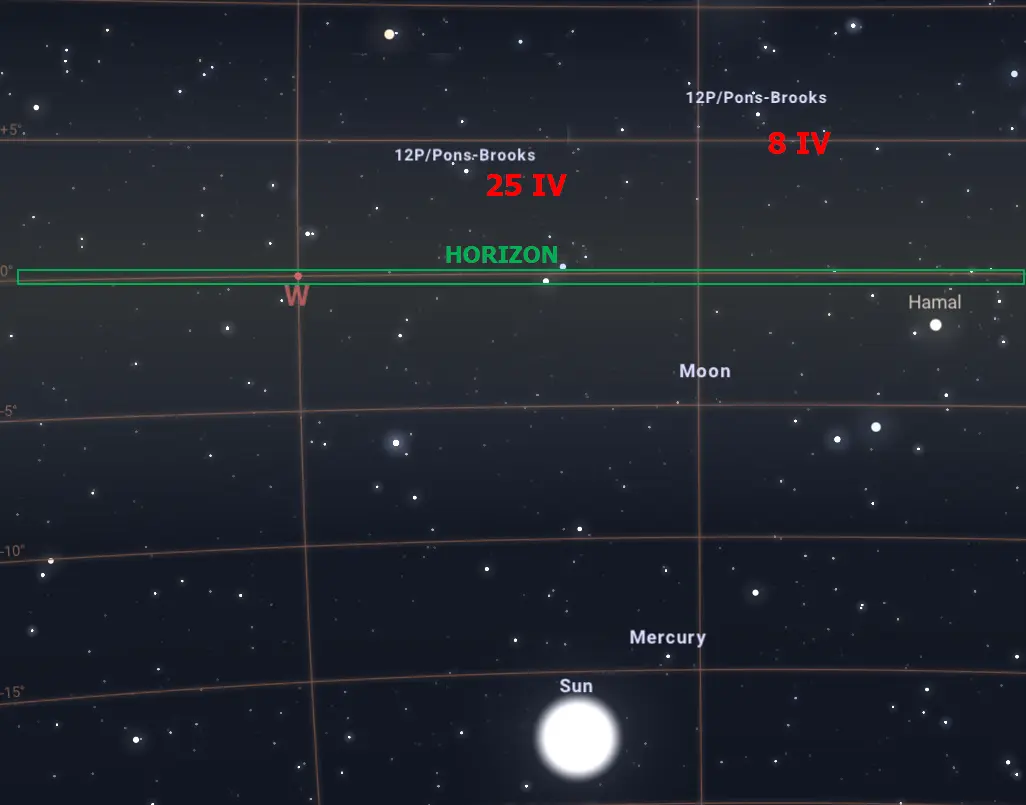
All the graphic stuff presented here clearly points out the solar eclipse below the horizon event as the best occasion for chasing the 12P/Pons-Brooks comet from at least January 1884! This is because the altitude of the comet on the French coast will be about 10° above the horizon in conditions resembling full night (analyze the following nomograph here). It will be the best place on land, however, you will find a theoretically better observation place from the ferry crossing the extended path of totality at West European Basin and the western part of the Bay of Biscay, where the totality will take place at the solar depression of 10-11°, which should resemble the full night conditions as far as the umbra extension in the nautical twilight sky is concerned.

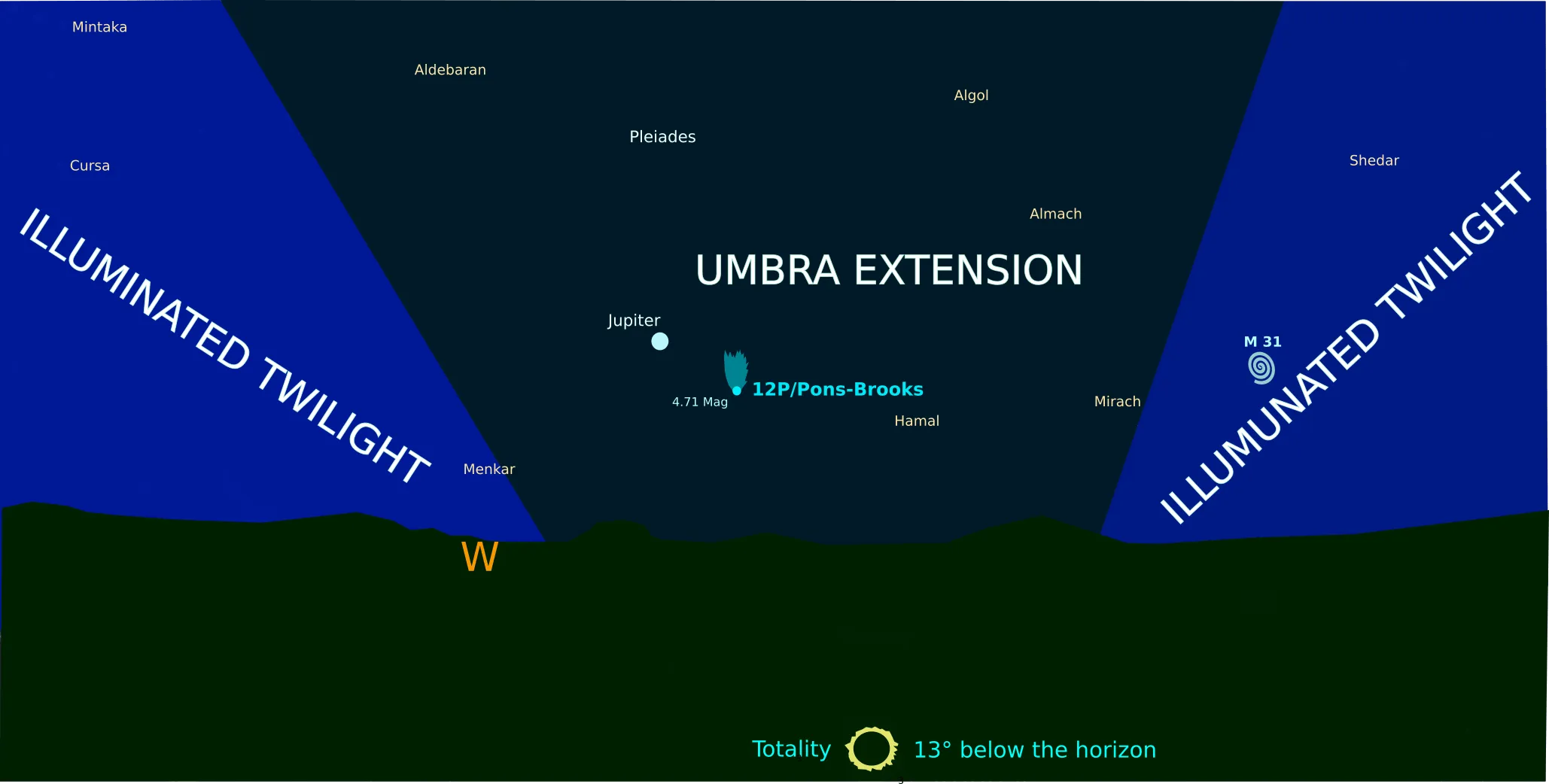
Because the observations from the ferry might not be the best taking into account, that the object is illuminated itself and not stable enough at open sea, we could conclude the western part of Nouvelle Aquitaine is the best place for the 12P/Pons-Brooks comet observation window. The totality below the horizon will last exactly 2m13s at the centerline. The comet is to create the triangle with Jupiter and Amphitrite (ε Tauri), which is the southernmost star in the Taurus constellation. All these bodies will be separated about 4-5° from each other.
5. WEATHER PROSPECTS
Considering the weather perspective for this event, anyone will take into account just one crucial element – the cloud coverage, which might include the fog, as the fog is nothing else but the stratus cloud. Because the eclipse event occurs in the evening, the probability of fog is lower than it could be during the morning. To tell the truth, the cloudiness might be a significant problem for all the locations considered along the geometrically extended path of totality as well adjacent areas with almost-total obscuration of the Sun being below the horizon. This article took into consideration three major observation venues in the UK, France, and Spain. This text focuses just on regions with obscuration of 90% and higher. All the areas considered for the eclipse below the horizon observation feature a climate shaped mainly by the Gulf Stream. Early April marks the end of the wet season in Western Europe, which is known for dynamic weather with low-pressure areas bringing rainfall to the Atlantic coast. The whole region falls within the Azores High, which gets stronger during the summer period. In the wintertime high-pressure area yields the Icelandic Low slightly. As the Icelandic Low presence increases, it gives way for gale winds blowing in the North Atlantic region The west winds take hold all year around bringing moist maritime air. As it enters land, it might result in building horizontal-layering low-level clouds, especially when encountering elevated areas like in northwestern Spain. The weather of western French and Spanish coasts is very dynamic with the ability to change even a few times daily. These areas lie in a maritime climate, which features quite frequent foggy, cloudy, and rainy days.
The simplest way of analyzing perspectives of clear skies is the combination of the satellite imagery from NASA, which clearly shows the cloud coverage over the solar eclipse below the horizon area across the last 24 years.

The image above presents the situation over the last decade roughly at noon, although in the chart below you can see the detailed percentage value of clear skies based on visual inspection, where the following degrees have been applied:
1 – clear skies
0.75 – cloud patches in the sky
0.5 – sky partially covered by clouds
0 – overcast sky or cloud gaps in the sky only
As is well known each type of cloud obstructs the view of any type of astronomical event. Regardless of their thickness, their presence is troublesome and deteriorates the observation quality. The solar eclipse below the horizon if it’s happening at the deep stage of twilight is doomed to failure when the sky is covered by clouds in more than 50%.
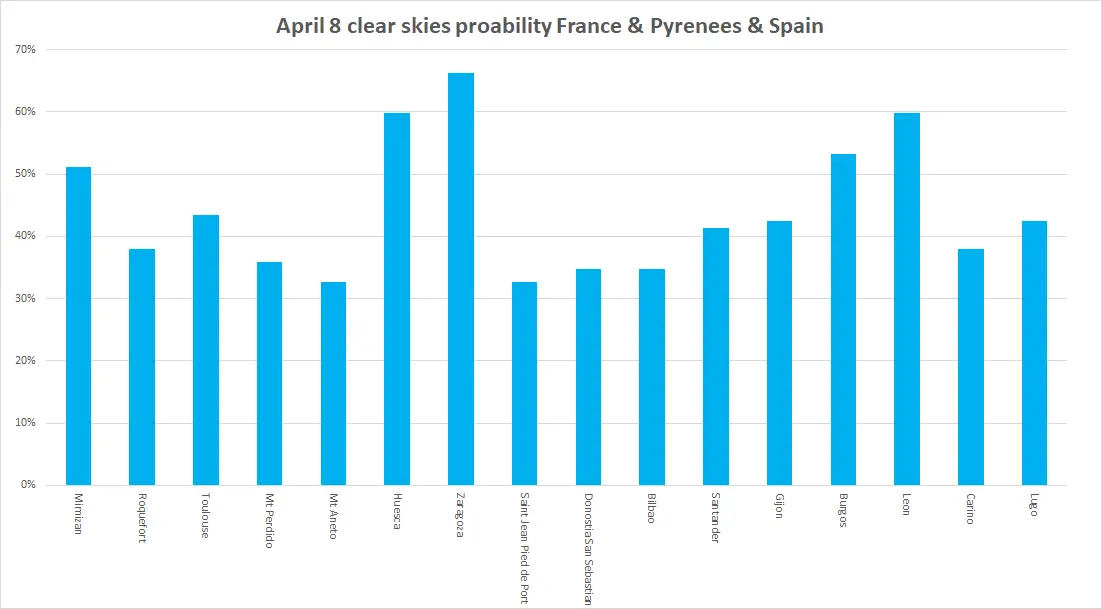
The values estimated manually are slightly lower than those computed by the weatherspark.com service. I’ve taken into consideration also the time of the day when the NASA images were taken. It was usually around noon or at most during the early afternoon, therefore we must be aware of some changes in the later part of the day. On a different note, there are various types of clouds covering the sky. The low-level cumulus clouds or even the vertically developed storm cells can move relatively quickly, the altostratus clouds usually veil the entire sky for a longer period.
By analyzing the results we can clearly show the worst locations for the 2024 solar eclipse below the horizon observation, which are Pyrenees summits. The best are located at Castille & Leon and Aragonia communities, located south of the Cantabrian Mountain chain and Pyrenees, which varies with the climate. The mountain ranges of north Spain are the basic division between the temperate and Mediterranean climates. Temperate maritime climates can be recognized by bigger cloudiness and precipitation around the eclipse day, which was mentioned earlier. The Mediterranean climate is better, but the rain and cloudiness take hold in the winter season, which basically ends around the eclipse day. As the example and charts below show, there might be a year, in which the solar eclipse below the horizon observation couldn’t be fairly possible.

The best example of it was the year 2000, in which the extended cloud formation covered literally the whole area of the greatest eclipse phase below the horizon. The only exceptions were regions slightly north of the extended path of totality between Bordeaux and Rhone Valley. There wasn’t even the smallest chance to see the event from Spanish territory.
In contrast to the year 2000, 11 years later the observers would be very happy if the eclipse event had occurred on April 8. The entire area remained clear with a high level of dust in places, which would affect the twilight sky appearance slightly.
Unfortunately, there are not any years such as 2011 within the analyzed region.
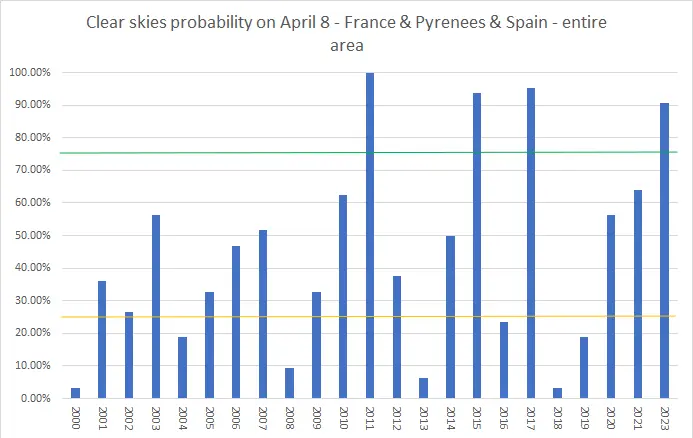
It’s easily readable from the chart above, which presents the April 8 clear skies over the entire region considered for the 2024 solar eclipse below the horizon observation. The years such as 2011 with almost 0 cloud coverage, or at least smaller than one of four areas with obstructed sky are just 4 within the entire analyzed period. Regrettably, we have more years such as 2000 on the other side, where the cloudiness envelops the sky in more than 75% whole area. For the clear skies percentage smaller than 25%, it’s really hard or rather impossible to carry out a successful eclipse below the horizon observation. There are 7 years between 2000 and 2023 with a situation such as this.
Another factor, that determines the probability of cloudiness in Western Europe likewise around the world is El Nino. The graph below shows the past occurrences of El Nino and La Nina with various intensities.

Next, we can correlate them with the clear skies occurring above the 2024 solar eclipse below the horizon area on April 8. However, no direct effect of these occurrences has been observed for this particular day. For example, on April 8 2011 when the sky was clear everywhere, the moderate La Nina was observed, the same as in 2008, which is entirely opposite with cloudiness. Next, the years with clear skies like 2015 or 2017 are characteristical for very weak El Nino or weak La Nina series. In conclusion, we could say, that El Nino won’t be helpful with the probability of clear skies. It will bring slightly worse conditions eventually because they usually affect jet stream above the Atlantic bringing slightly colder and wetter winters. Another phenomenon, that shapes the weather in this part of Europe is the North Atlantic Oscillation, which tells us about the fluctuation of atmospheric pressure at the Sea Level between the Icelandic Low and the Azores High. When NAO has a positive value, it means, that the Azores High is larger than normal. As a consequence in the winter, we can observe wetter weather in northern Europe and eastern USA in account of dryer weather in southern and southwestern Europe. Conversely, when the NAO index is negative, the situation reverts bringing more precipitation and bad weather to southwestern Europe. The chart we can find here (Pic. 53). However no big correlation has been found with the satellite imagery presented earlier.
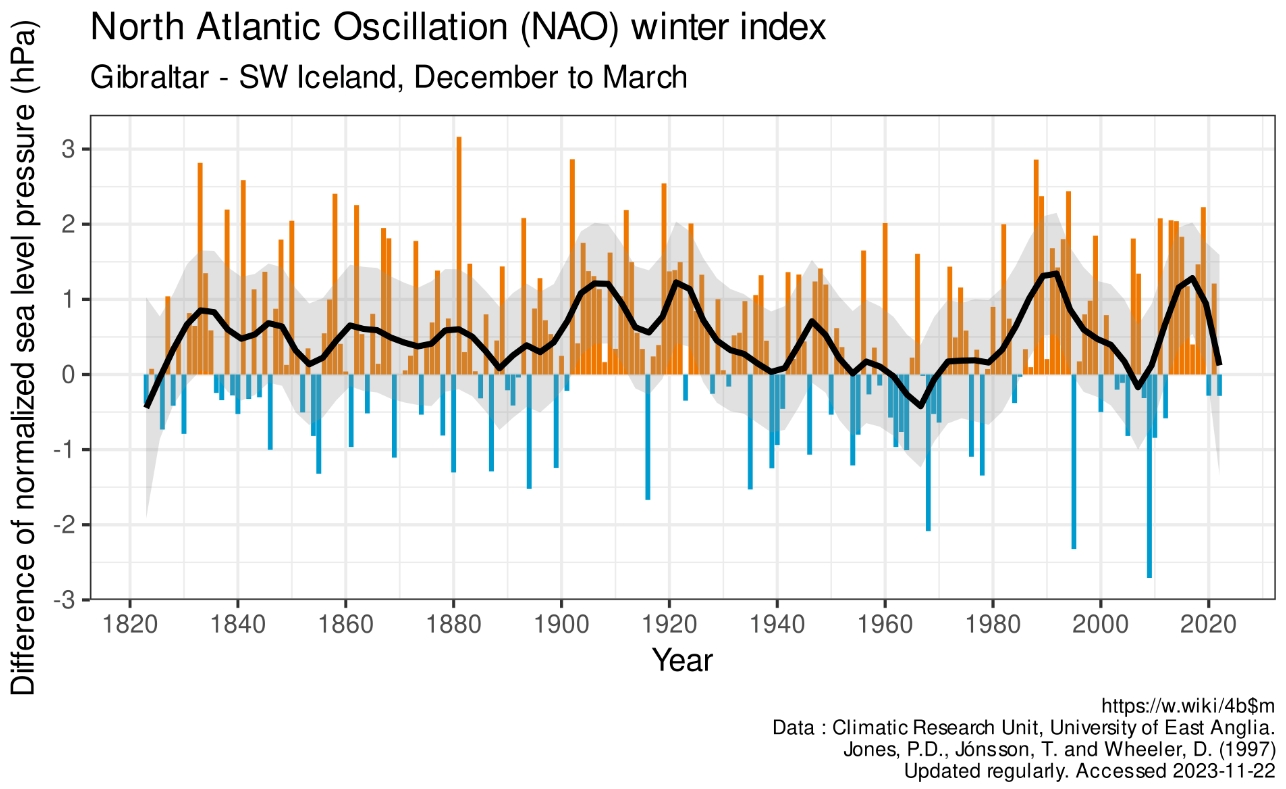
In fact, we are the most interested in the cloudiness conditions specifically at the time of the eclipse. Let’s consider the timeframe between 6 pm and 9 pm UTC. The Weatherspark.com website can provide graphs of clear skies with the hourly breakdown. Let’s see them below for the specific locations considered in this text.

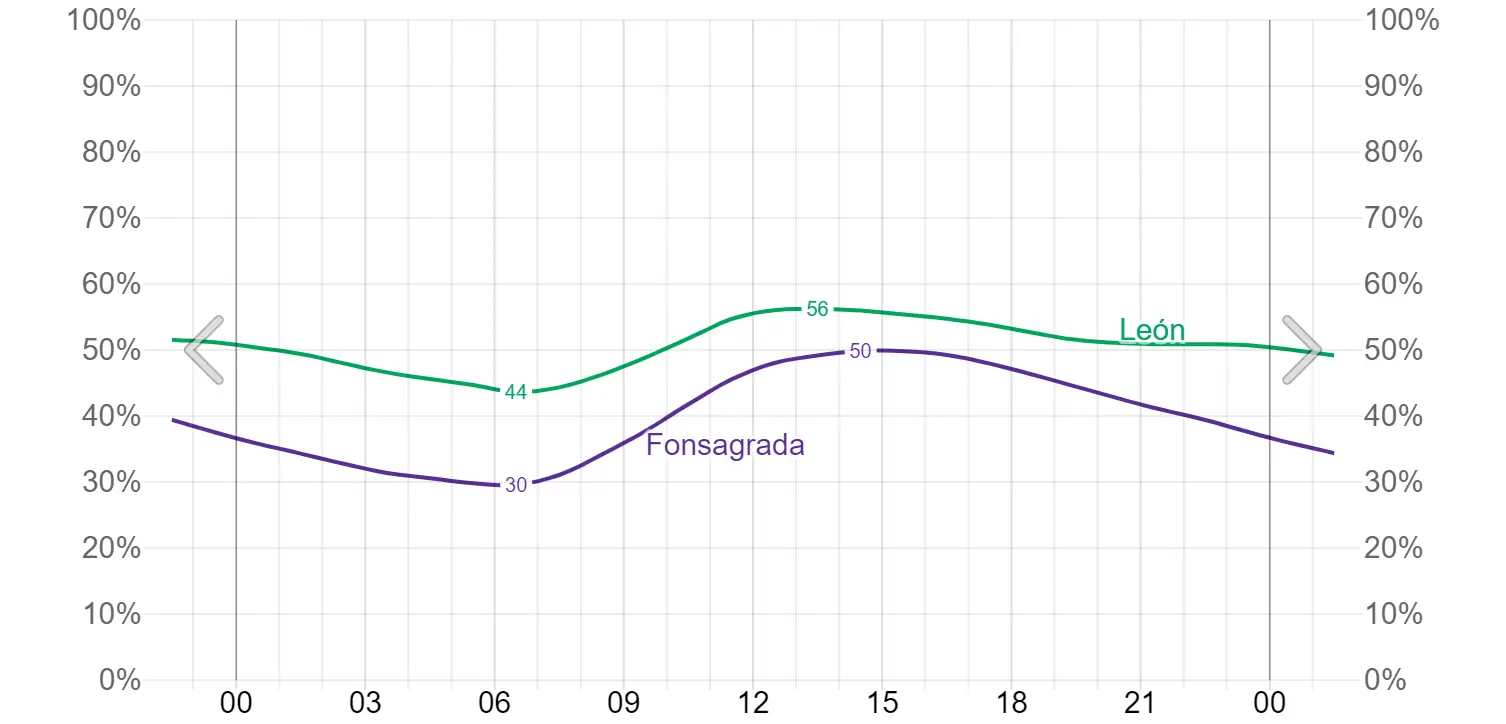


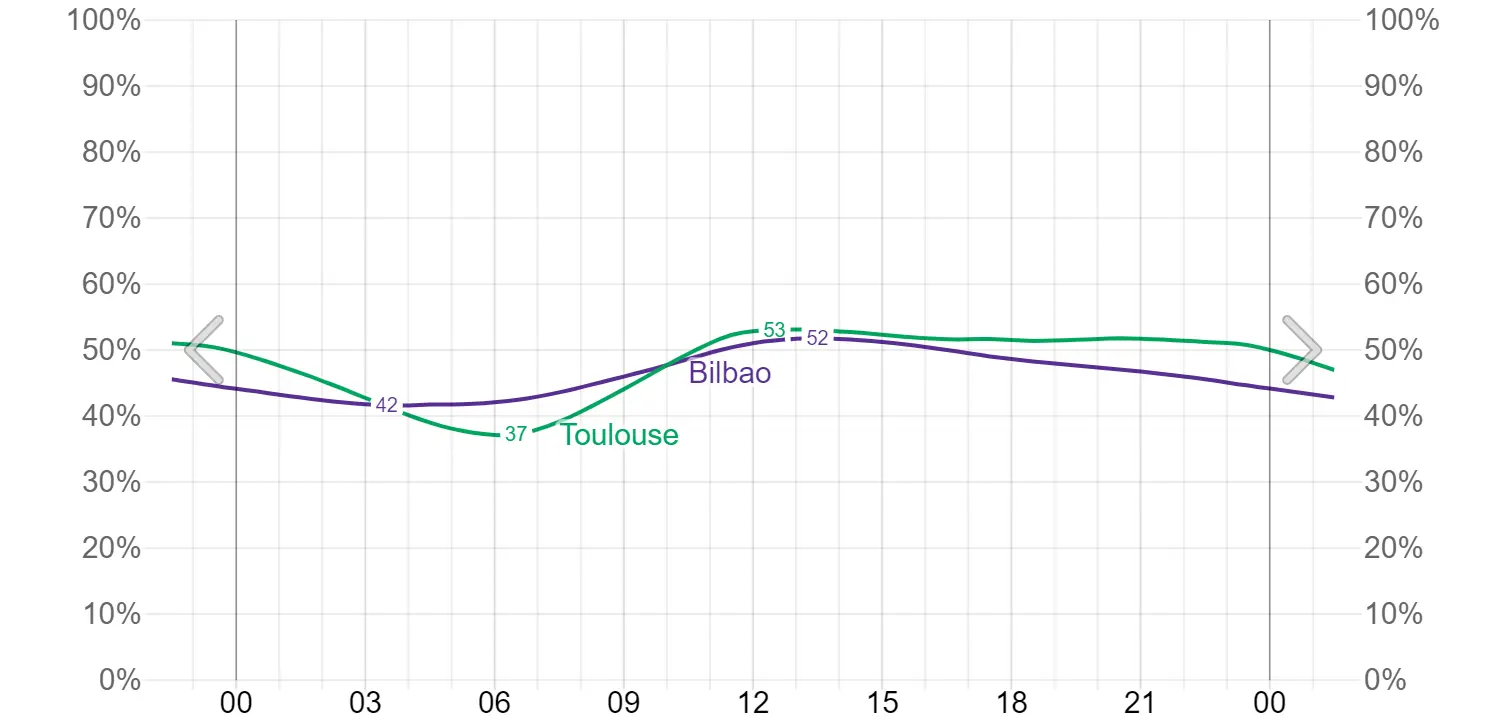
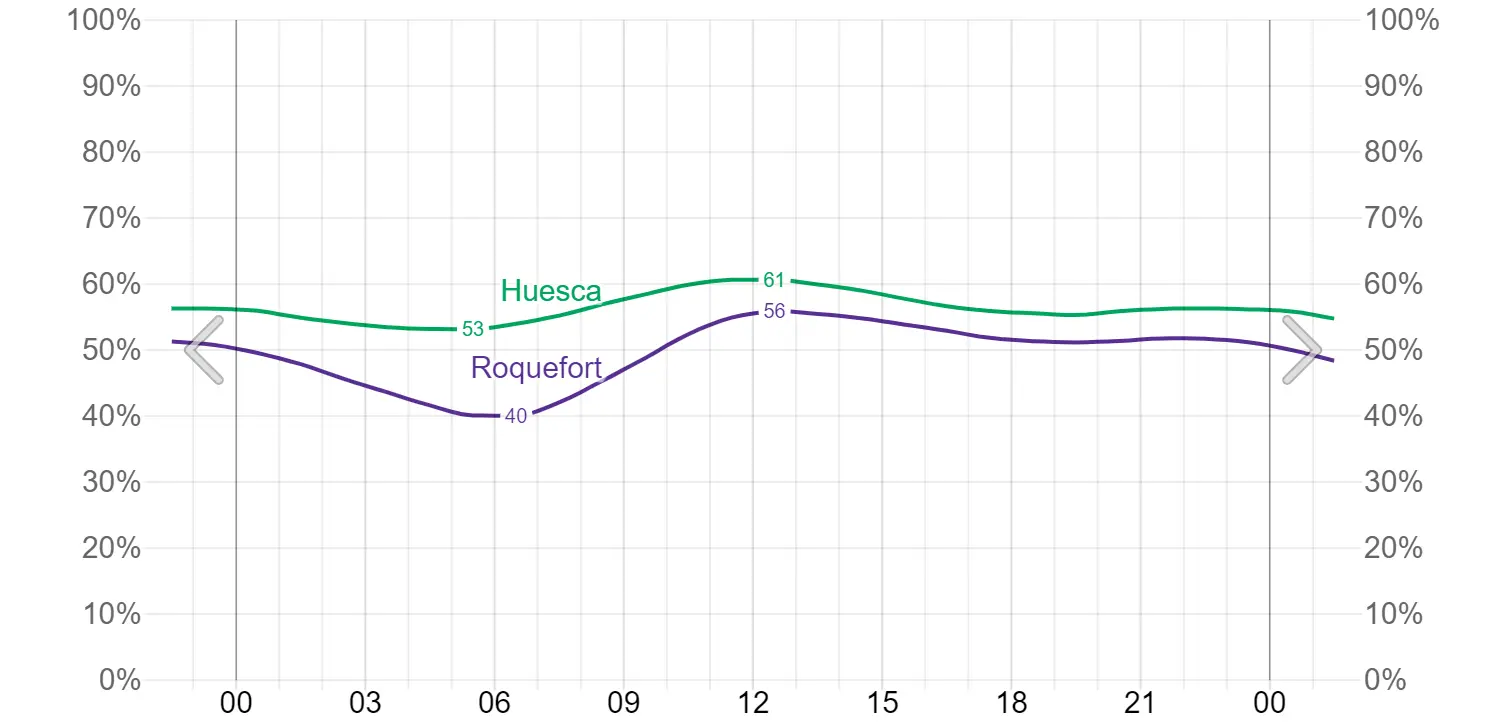
In all the cases the biggest chances for clear skies occur in the early afternoon. Later as the Sun goes down the statistical probability of cloudiness increases, which is driven by the increment of humidity level. The low-level layered cloud decks might form in the evening and overnight with the biggest coverage in the early morning hours, which is shown in the above patterns. Fortunately, the eclipse below the horizon effect takes place at the beginning of the night, when contrary to dawn, the probability of clear skies is higher.
6. LIGHT POLLUTION
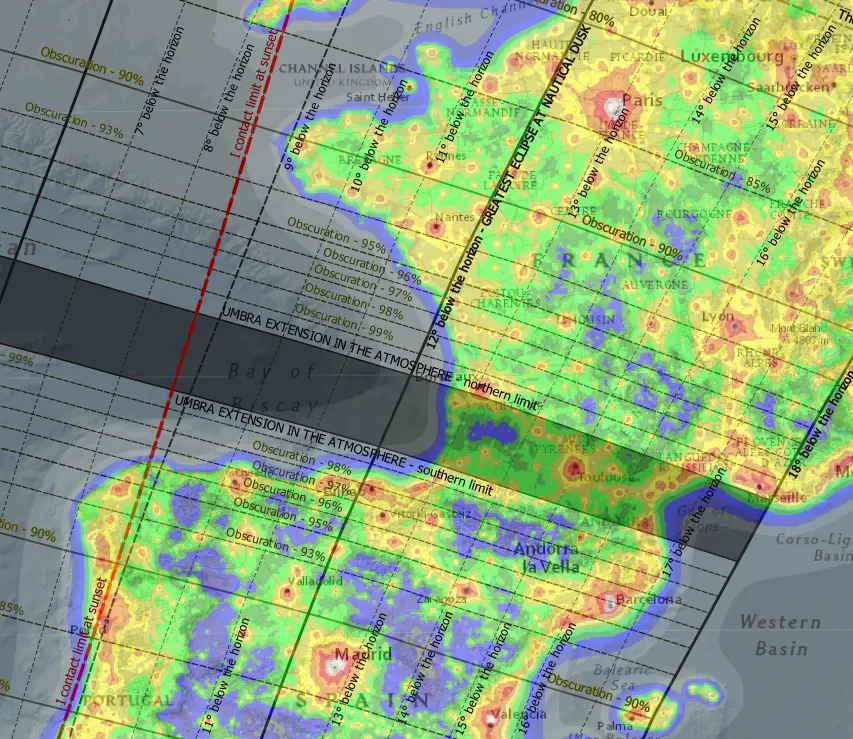
6.1 France
Despite the large area, as France is the second largest country in Europe, there is only a little space for stargazers.
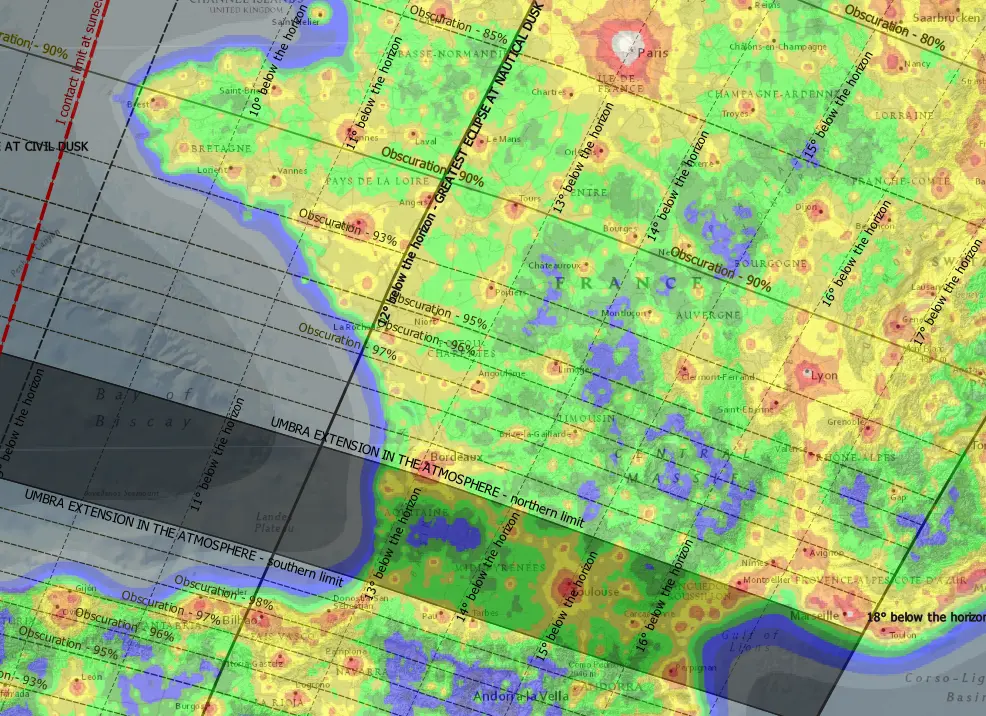
The clearest skies are located along the highlands (Morvan, Massif Central), densely forested areas in Nouvelle-Aquitaine, and some Alpine regions (Pre Alps du Dauphine, Maritime Alps, Ecrins). The observers can get at most the Bortle 3, although there is one exception.
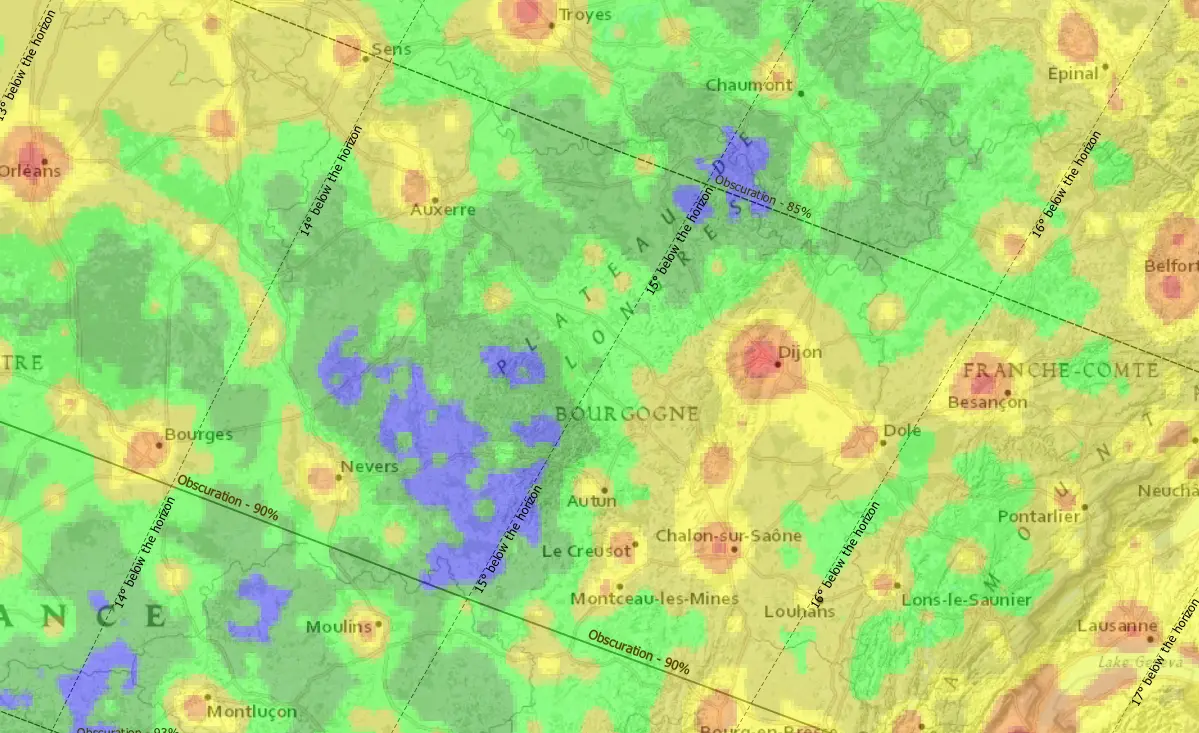
The northernmost darkest site in French territory is located at Morvan mountainous massif, especially within the boundaries of Morvan Regional Natural Park. The majority of the area features Bortle 3 and Bortle 4. The SQM value reaches 21.89 mag/arc sec2 in the northern areas of this natural park east of Brassy municipality. The total area of clear sky such as this stretches between Dijon and Nevers at a distance of about 60km, which should be enough for watching the April 8 dusk. The greatest phase of the eclipse occurs at mid-astronomical twilight with obscuration between 85 and 90%.
Slightly better stargazing conditions are inside Massif Central, where typical is Bortle 3 and in the minority the Bortle 4 around some small towns. There is one exception mentioned earlier in this chapter. Namely, the surroundings of the Gentioux-Pigerolles commune have the darkest sky in France with the SQM value exceeding 21.9mag/arc sec2, which gives the Bortle 2.
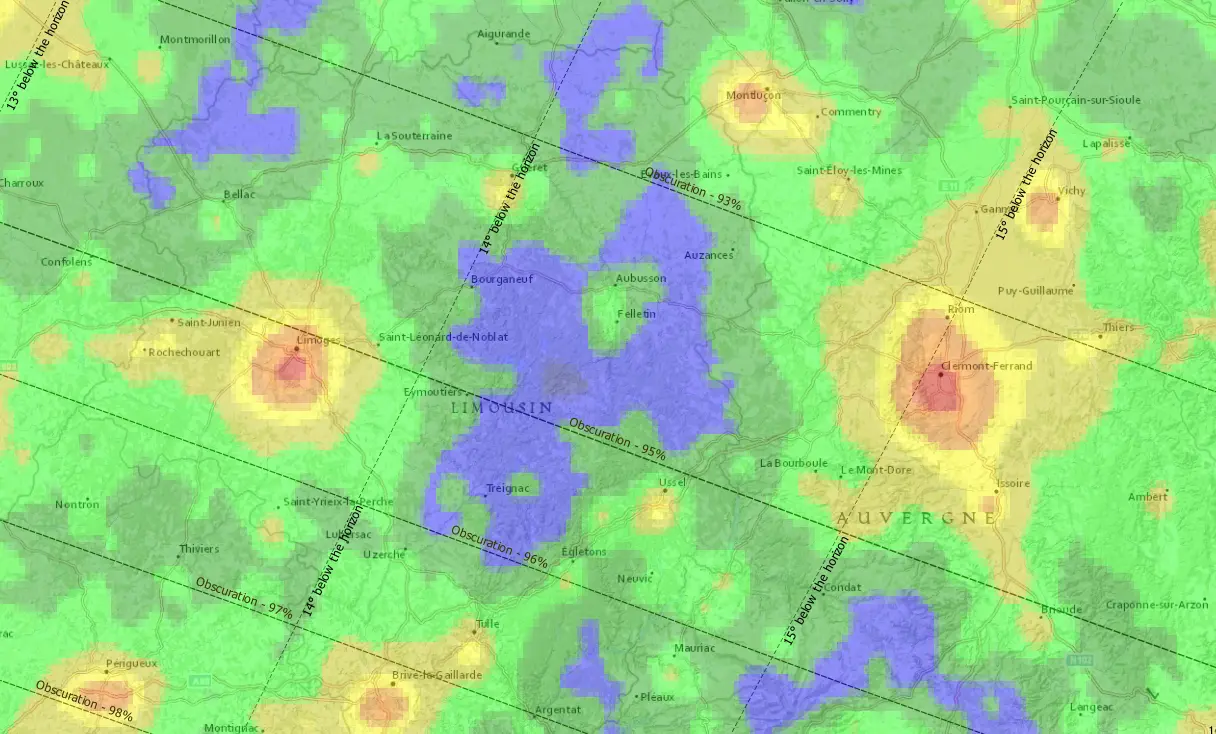
Moreover, the entire dark area stretches up to 250km from north to south and over 60km from East to West when considering the straight line between Clermont-Ferrand and Limoges. The area with Bortle 3 expands also in the northwestern direction towards the department of Indre, where the SQM value reaches 21.9mag/arc sec2 locally.
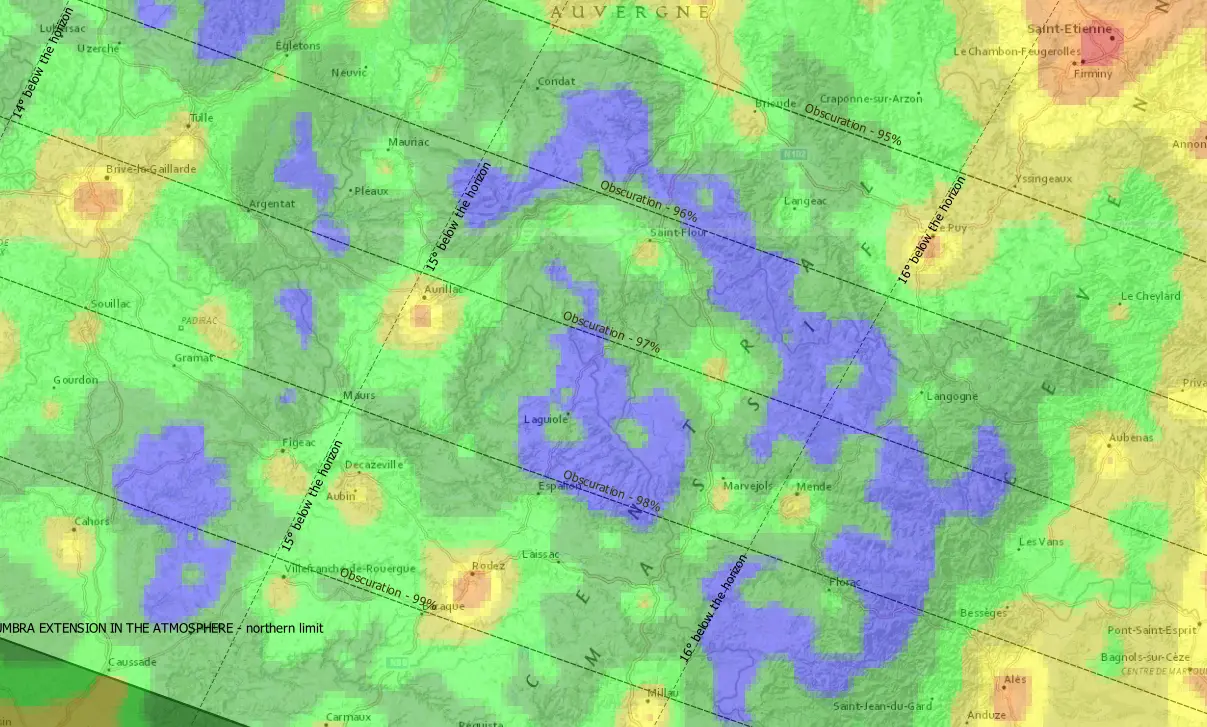
The southern part of Massif Central can be still fine for the solar eclipse below the horizon observation as the sky brightness is predominantly in the Bortle 3 scale. The best sky is at Montclair State Forest east of Cahors town. The SQM value obtained there is 21.86mag/arcsec2. Just a tad brighter sky, but a better scene can be seen in the western part of Cevennes National Park. The SQM value there reaches 21.82mag/arcsec2 and reflects a typical rural sky. Indeed, the national park area is significantly polluted by the Rhone Valley from the east, where a lot of cities are located. It’s not a problem with respect to the 2024 eclipse situation as potential observers will keep looking at the western and northwestern horizons, which remain unobstructed by artificial light at a distance longer than 50km in a beeline. The maximum eclipse will be observed at a solar depression of over 16°, which gives a quite small chance for a good record.
The easternmost site with the relatively clear sky is located just a front of Alpes.
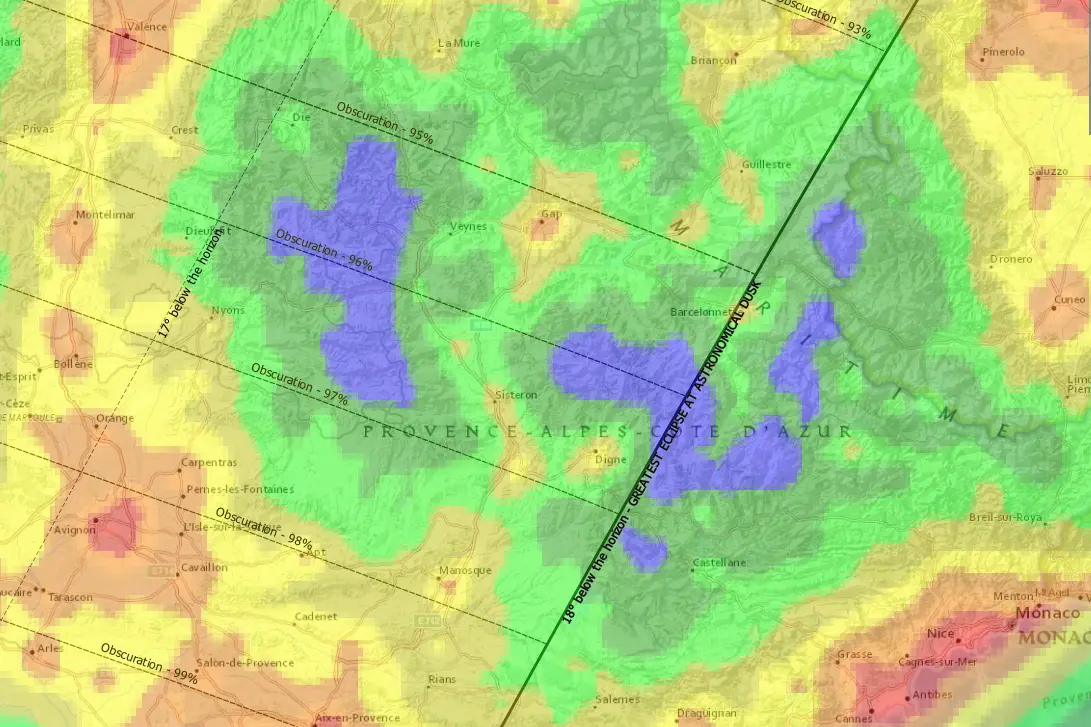
The Maritime Alps range will be beyond the twilight zone. The only thing, that could be barely noticed from there is just the acceleration of the later part of the nautical twilight, but long exposure will be definitely required. The elevation above sea level will give some horizon dip. Unfortunately, the Bortle 3 sky might be not enough for an observation such as this. Just a bit better prospect of the 2024 solar eclipse below the horizon circumstances could be for the Dauphine Alps range, where the maximum is to occur at a solar depression of 17°, so just before dusk ends. The impressive obscuration of 96 and 97% will probably fade out any small illumination of the sky in solar direction, which is usually barely noticeable in non-eclipse conditions.
Contrary to the Alpes, undeniably the biggest chance for chasing the solar eclipse below the horizon effect will occur in the central Nouvelle Aquitannie region, which is covered densely by forest. The border between Gironde and Landes departments has the Bortle 3 sky brightness expanded at E-W directions and a distance of almost 80km between Captieux and Roquefort towns connected by the A65 road. The SQM value gets easily 21.85mag/arcsec2, which should be fairly enough for chasing the dusk disturbance by the total solar eclipse 2024 extension, which occurs at the solar depression of « just » 13-14° here.
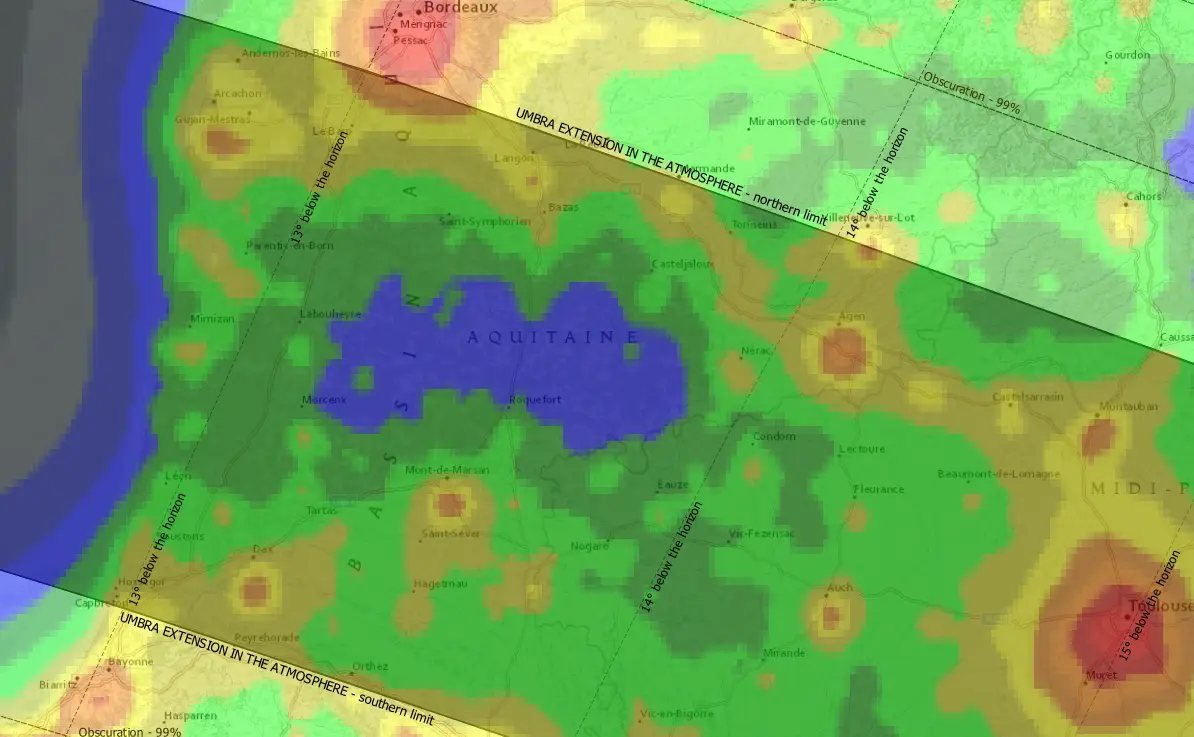
Despite dense forests, there are places in this area, where the pine trees aren’t high or there are some large sections free of trees at all and they guarantee an open horizon. The lack of any elevated places can be the pain.
As an alternative, the observer could pick the Gulf of Biscay shores south of Mimizan village. The darkest sky seems to be roughly at Plage du Cap de l’Homy with an SQM value of 21.77mag/arcsec2 which still corresponds to the Bortle 3 scale. Again, the utter lack of elevated venues can be a disadvantage here. This place lies roughly at the extended eclipse centerline. The umbra in the atmosphere should be visible for 2m13s here (as well as elsewhere where the extended eclipse centerline is concerned) at a solar depression of 13°. Normally, at the very beginning of astronomical dusk, the horizon remains quite bright, but due to eclipse conditions, I am wondering about the final optical effect.
6.2 Spain
The Spanish sky is darker in places, although not necessary in the strict areas with the best solar eclipse below the horizon circumstances.

Because of the event circumstances, it shouldn’t wonder that the best location will be the northwestern corner of the Iberian Peninsula, where the greatest phase occurs just before mid-nautical dusk or around mid-nautical dusk. The surroundings between the Cedeira and Carino municipalities, especially at the Vixa da Herbeira hill have at most the Bortle 4 sky brightness with the SQM value of 21.68mag/arcsec2. It’s just a tad worse than at the northernmost tip of Spain – the Punta de Estaca de Bares, where the Bortle 3 sky brightness can be obtained with the SQM value of 21.74mag/arc sec2, although this situation refers to the very tip only. At the Villa de Bares settlement, the SQM value decreases to 21.52mag/arc sec2. The obscuration at these two locations exceeds 96% and the geometrical distance to the extended southern limit of the umbra is around 130km northwards, so the shadow should be clearly visible in the northwestern part of the sky.
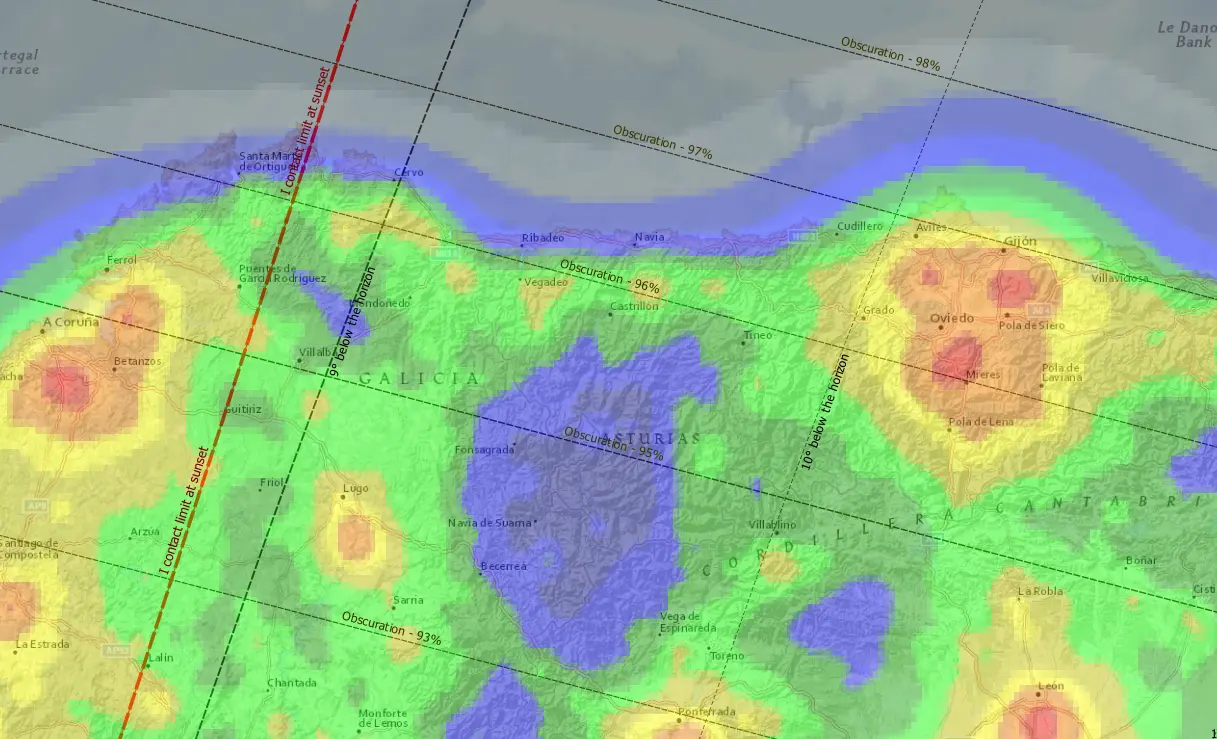
Interesting is the adjacent region – the Serra do Xtral mountain range, which is located slightly south of the Gulf of Bothia coast. The Bortle 3 sky brightness can be obtained there at a distance of about 15-20km. Observers going there will lose about 0.5% of obscuration against the previous areas, but in exchange for it, the area seems to be much clearer from artificial light glowing visible around. The SQM value typical for this area is 21.72mag/arc sec2.
The best stargazing conditions in the Galicia region are at the eastern border with Asturias region, where the highest part of Galicia Massif is located. The mountain ranges such as Serra dos Ancares, Serra dos Courel or Serra do Eixe can feature the Bortle 2 sky brightness where the SQM value reaches 21.91mag/arcsec2. The problem here is, that these locations are further from the 2024 total solar eclipse umbra path extension. The obscuration there is just between 93 and 95% at the greatest phase occurring when the Sun is almost 10° below the horizon.
The darkest sky in the area nearby is located in the western part of the Castile and Leon region near the Portuguese border. The SQM value reaches 21.92mag/arcsec2 whereas the eclipse below the horizon circumstances points out the obscuration of 90% at the solar depression of almost 11°.
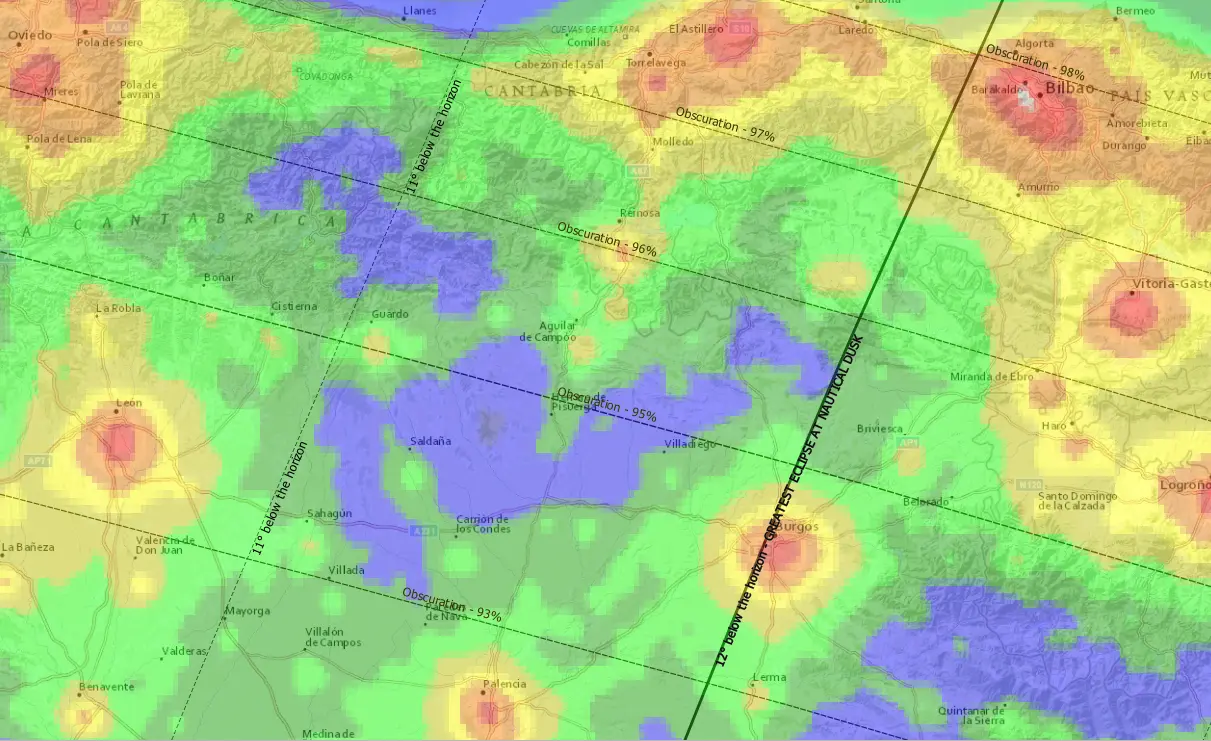
The eastern part of the Cantabrian Mountains gives conditions for Bortle 3 sky brightness, especially within the Picos de Europa National Park, where the estimated SQM value is 21.88mag/arc sec2. The eclipse below the horizon magnitude is roughly the same as at the northernmost tip of Spain, but the greatest event occurs shortly before the end of nautical twilight. Another area with a dark sky is located at the southern backdrop of the Cantabrian Range within the Castile and Leon region. People who live there can enjoy even Bortle 2 sky brightness locally with SQM value hovering at 21.9mag/arc sec2 at a distance of just 20km.
There are 2 other and larger areas of dark sky in Spain. The first one are Pyrenees range, which lies very close to the extended path of the 2024 totality. The French-Spanish border gives you usually the Bortle 3 sky brightness, but the southern slopes at Ordesa National Park have a Bortle 2 level of sky brightness (SQM value of 21.9mag/arc sec2). Unfortunately, because the main range of the Pyrenees rises from the north, the northwestern horizon, where the solar eclipse below the horizon takes place might be seriously obstructed. This is particularly important because of the fact, that the greatest eclipse phase occurs almost at mid-astronomical dusk. Considering the great obscuration reaching 98%, the event won’t be noticeable that much then.
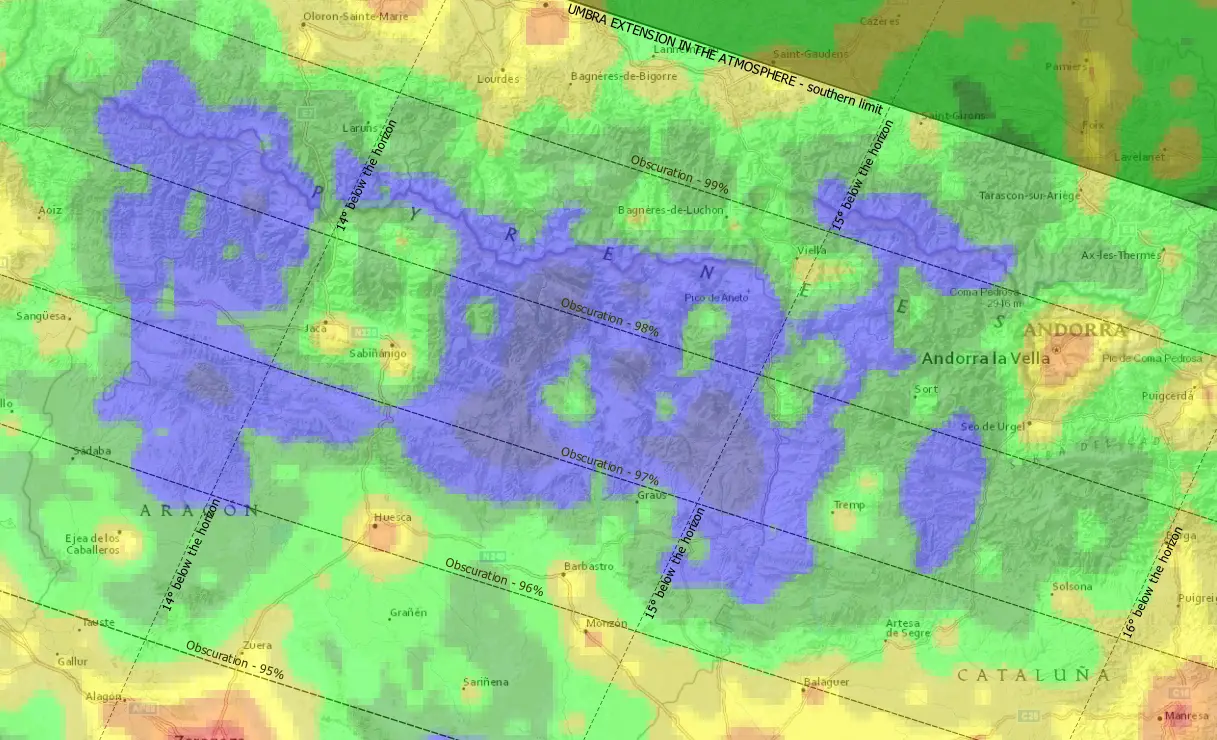
The best conditions for the 2024 solar eclipse below the horizon observation will be at the southernmost Pyrenees ranges i.e. Sierra de Guara mountains in Huesca province, which is separated from the main Pyrenees range and thanks to this the northwestern horizon seems to be more open. The obscuration of 97% at mid-nautical twilight can still give a chance for noticing, that the twilight is different than normal. The distance to the southern limit of the umbra extended in the atmosphere is just 120km from here, but the northeastern horizon is not favorable at all at this stage of dusk.
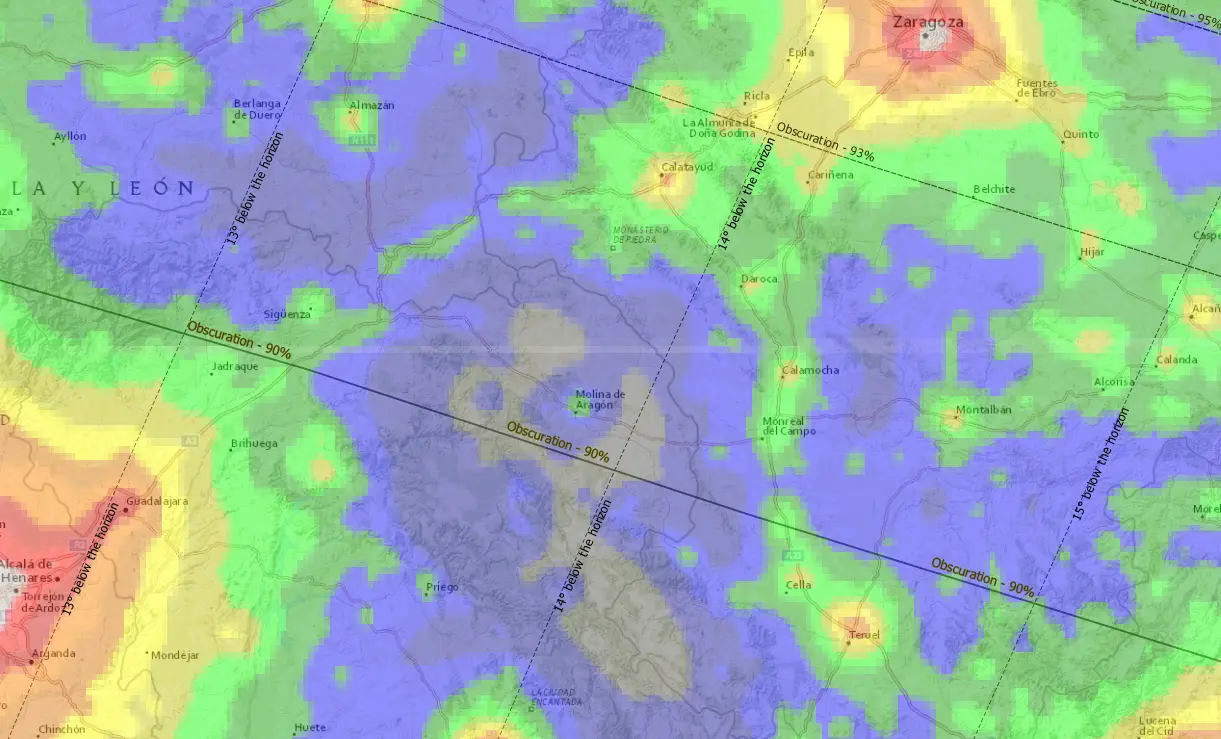
The largest area of the dark sky considered with respect to the 2024 solar eclipse below the horizon and one of the largest dark sky areas in Spain stretches from easternmost areas of the Castille and Leon region and next along the border of Asturias & Castilla La Mancha where the Sistema Iberico mountain range stretches. This is the second darkest area in Spain, where the SQM meter would give you the value of 21.93mag/arcsec2. It’s the « strong » Bortle 2 sky brightness level and it would be definitely beneficial for watching the solar eclipse below the horizon if it were closer. The whole area is longer than 200km in the NW-SE direction and over 100km in the W-E direction with an average obscuration level of 90% and solar depression of 14°, so despite the significant distance to the extended umbral path in the atmosphere, the event should be clearly noticeable. Unfortunately, the total distance to the southern limit of the extended umbra is nearly 320km from there, which at this stage of dusk rather won’t be noticeable.
7. POTENTIAL OBSERVATION VENUES
7.1 France
France could be good with respect to observation venues, as the extension of totality passes through almost the entire country. The major problem is the stage of dusk in which the greatest phase takes place. Considering quite a big solar depression and the light pollution, there are only a few spots from which an observation such as this could be recommended. Basically, the observation should be focused on chasing the presence of the umbra in the atmosphere and the solar F-corona (zodiacal light), as proposed by Guliaev. It’s only the perfect position for the 12P/Pons-Brooks comet observers, which has been discussed in an earlier chapter.
7.2 Spain
The observers can find quite a lot of interesting venues in Spain due to its varied landscape. In fact the most important is the northern part of the country, which lies close to the extended path of totality, not to mention, that theoretically, the umbra could be visible from there. On top of that northern Spain is the region, where the greatest phase occurs at the lowest solar depression, therefore the twilight disturbance should be visible well. The observation could be aimed at both the 12P/Pons-Brooks comet, which in the dusk affected by the deep eclipse phase should be visible quite well as well as the twilight standstill phenomenon, which will be noticeable basically in the whole Iberian Peninsula, but at different moments. I would advise to watch the northwestern section of the sky, where the umbra can be noticeable. Since the greatest phase will occur at mid-nautical twilight this is fairly plausible!
Assuming, that the weather is good, we could place ourselves on the mountain tops, although a more reasonable approach could be set just on the highlands.
7.3 Switzerland
Observation of the event from Switzerland definitely excludes chasing the 12P/Pons-Brooks comet, as the object is at most 5° above the horizon. The aim of observation could be oriented to the small difference between non-eclipsed and eclipsed end of twilight.
8. RESOURCES
8.1 Webcams
The entire area covered in this article is wealth with various webcams located randomly. Of course, their quality is different, although we should be mindful of their framing direction as well as the frequency of image capture. Usually, when the webcam operates in live mode it’s hard to get it working efficiently at night. This problem has been mentioned in this article and will be developed further. On the other hand, there are some high-quality cameras covering the scene in some periods of time. For the event, which is the total solar eclipse below the horizon, these cameras are rather useless despite their quality. The eclipse event is too elusive against the fixed timing of image capture by the given webcam. If, for example, the camera takes a picture every 5 minutes, the greatest eclipse with total length computed at 2m13s might be unnoticeable. The last and I believe the key thing is the backup if it exists at all. Some webcams store their records for some time and it’s very convenient for observers, who can browse it when return from observation on site. Unfortunately, quite often happens, that webcams don’t have backups. It means, that they must be loaded on our device when the event occurs. Below I prepared several of the best webcams, which could provide decent records of the 2024 solar eclipse event from Western Europe. The knowledge about the specificity of this observation is required, which is covered in the next chapter.
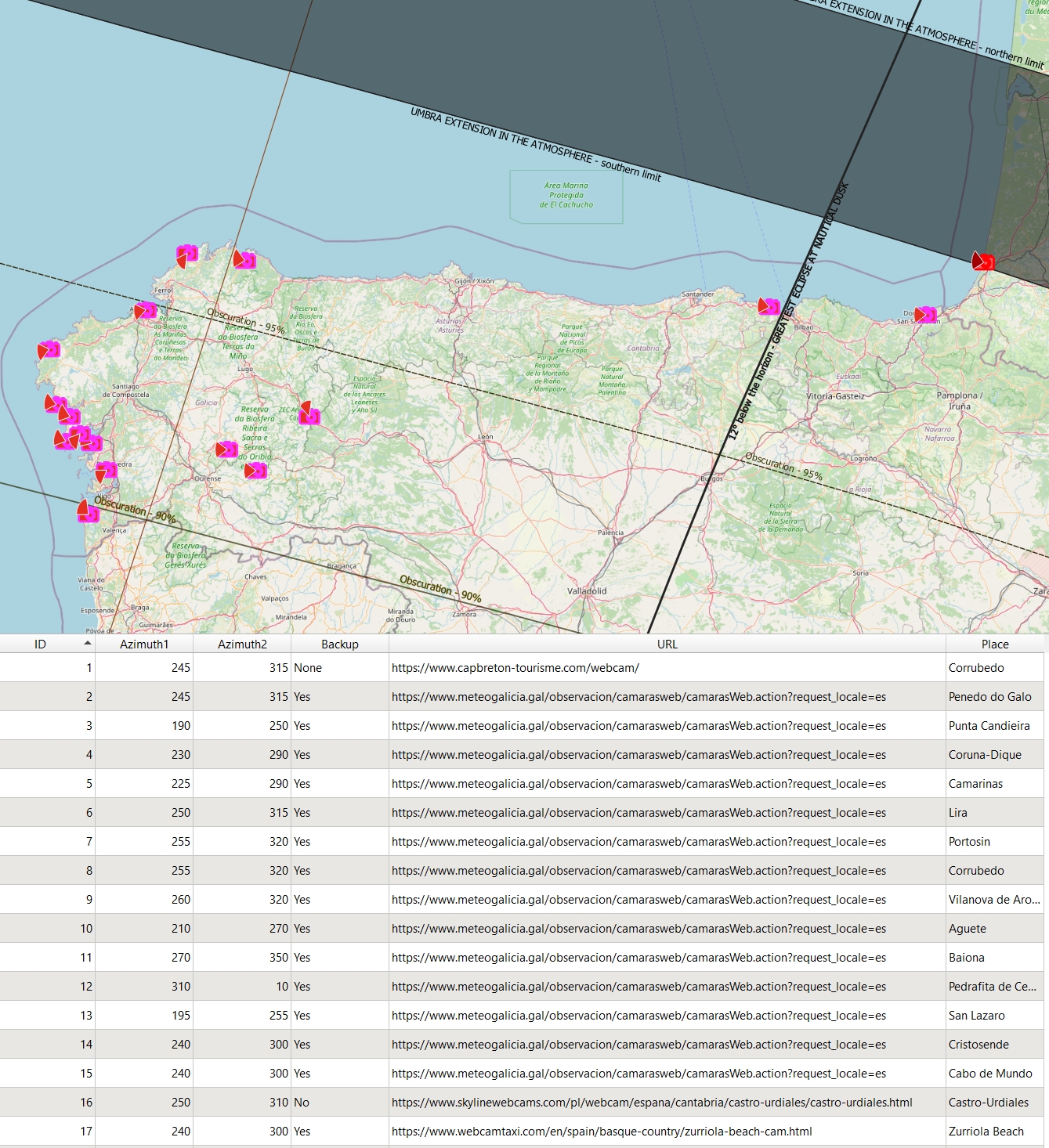
The image and list above include the webcams operating in the area, where the eclipse view will be the most favorable. There are quite a lot of webcams and providers operating within the Iberian Peninsula and western France. However vast majority of them don’t have a backup option as they operate live. It requires a (virtual) observer to stick to his screen and record the moment of the eclipse. The map presents only the webcams with the backup, which includes the timelapse from the previous day or at least 12 hours of playback. The best webcam operator in northwestern Spain is Meteogalicia, although, in my opinion, it’s still far from ideal. In light of the specificity of this phenomenon, these cameras might be useless as they operate with low ISO sensitivity. The horizon background disappears at early nautical twilight. When watched online they show dark scenes, but when the timelapse is downloaded, it covers only the period of daylight + early stage of twilight until the horizon is black. In practice, it will be still hard to record something on April 8 evening. The red-marked webcam has no playback at all but records roughly from the negative path of totality towards the solar direction.
8.2 Casual « Eclipse » flights
There are commercial flights, that operate between Western European countries at the same time when the 2024 solar eclipse will occur.
The image below shows the number of commercial flights « crossing » or at least approaching the extension of the 2024 totality in Western Europe if it could happen on Monday, April 3, 2023 (April 10 was Easter Monday).
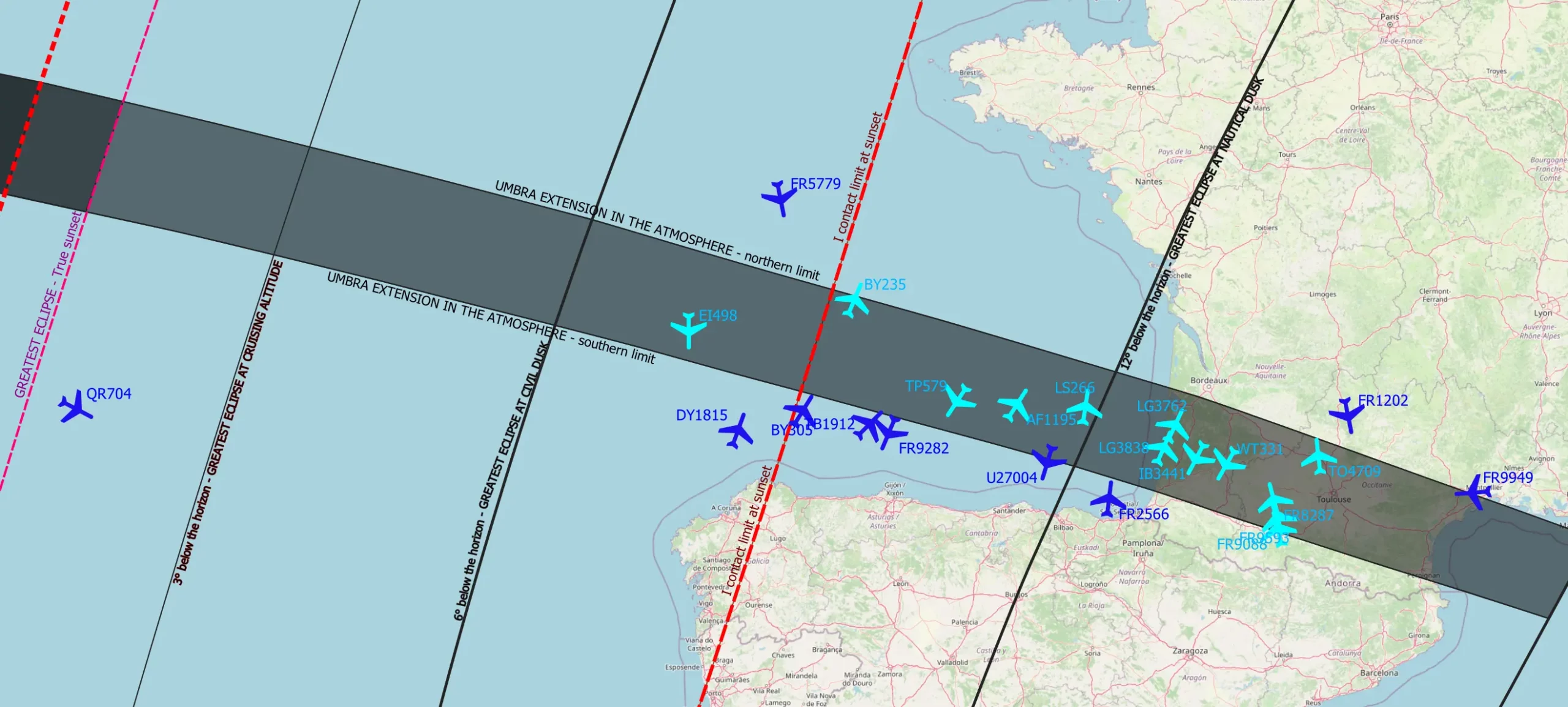
The table below is updated with the commercial flights available for booking on Monday, April 8 2024 evening. All these flights are estimated to be around the extended path of totality roughly at 19:54 UTC. It’s hard to assume their position right now, as their departure is usually belated.
Tab. 1 The list of regular flights, which potentially can cross the extension of the 2024 eclipse path. All the details in the local time.
8.3 Casual « Eclipse » cruises
The same as commercial flights, we can be a passenger on some cruise, that operates between i.e. the Iberian peninsula and the British Isles and can « cross » or at least approach the extended path of totality at the rough moment of the maximum eclipse.
The image below displays the marine traffic against the eclipse path across the North Atlantic if it could happen on Monday, April 3, 2023 (Monday 10 was Easter Monday).
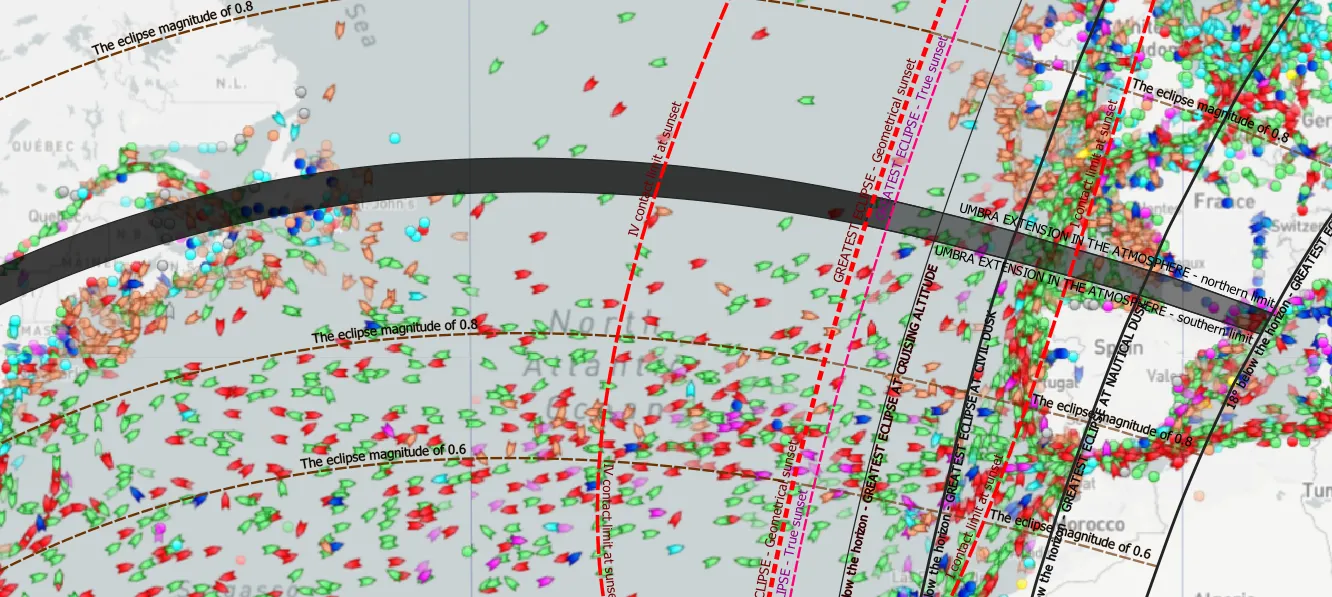
The table below is updated with the commercial cruises available for booking on Monday, 8 April, or preferably Sunday, April 7. All these cruises are estimated to be around the extended path of totality roughly at 19:54 UTC.
Tab. 2 The list of regular cruises, which potentially can cross the extension of the 2024 eclipse path. All the details in the local time.
9. OBSERVATION GUIDELINE
The solar eclipse below the horizon requires a specific approach to the observation. Regardless of our goal, the common denominator is the proof, that twilight looks different than normal. Apart from the light level measurements, which can be occasionally done, the easiest will be a visual way of evaluating the twilight progress. For this reason, even the casual observer should take images of the western horizon consequently in fixed periods of time. By understanding the fixed periods of time, we can assume that they will be defined by the specific value of solar depression. Next, the same sequence of photography must be repeated by non-eclipsed twilight, exactly for the same moments of given solar depression. This series of images could be taken twice, where one block could cover the changes of illumination and another one the changes of sky coloration. The deep eclipse magnitude means, that the sunlight is strongly affected by limb darkening. In turn, it shifts towards red. As a result, we should expect a redder tinge of the twilight sky than normal. It would be vital to cover the entire sky, but the solar direction is the most important I believe. Another issue arising out of the event is the earliest moment when some celestial bodies start to be visible. We know, that the brightest stars are visible before the end of civil dusk. Will they become visible earlier for the observer when the solar eclipse below the horizon takes place? What sky coloration should we expect, when the deep solar eclipse event occurs at twilight? Because of the eclipse-induced sky coloration changes the blue hour might not be blue enough.
See the pattern below showing how the solar eclipse below the horizon observation should look like.
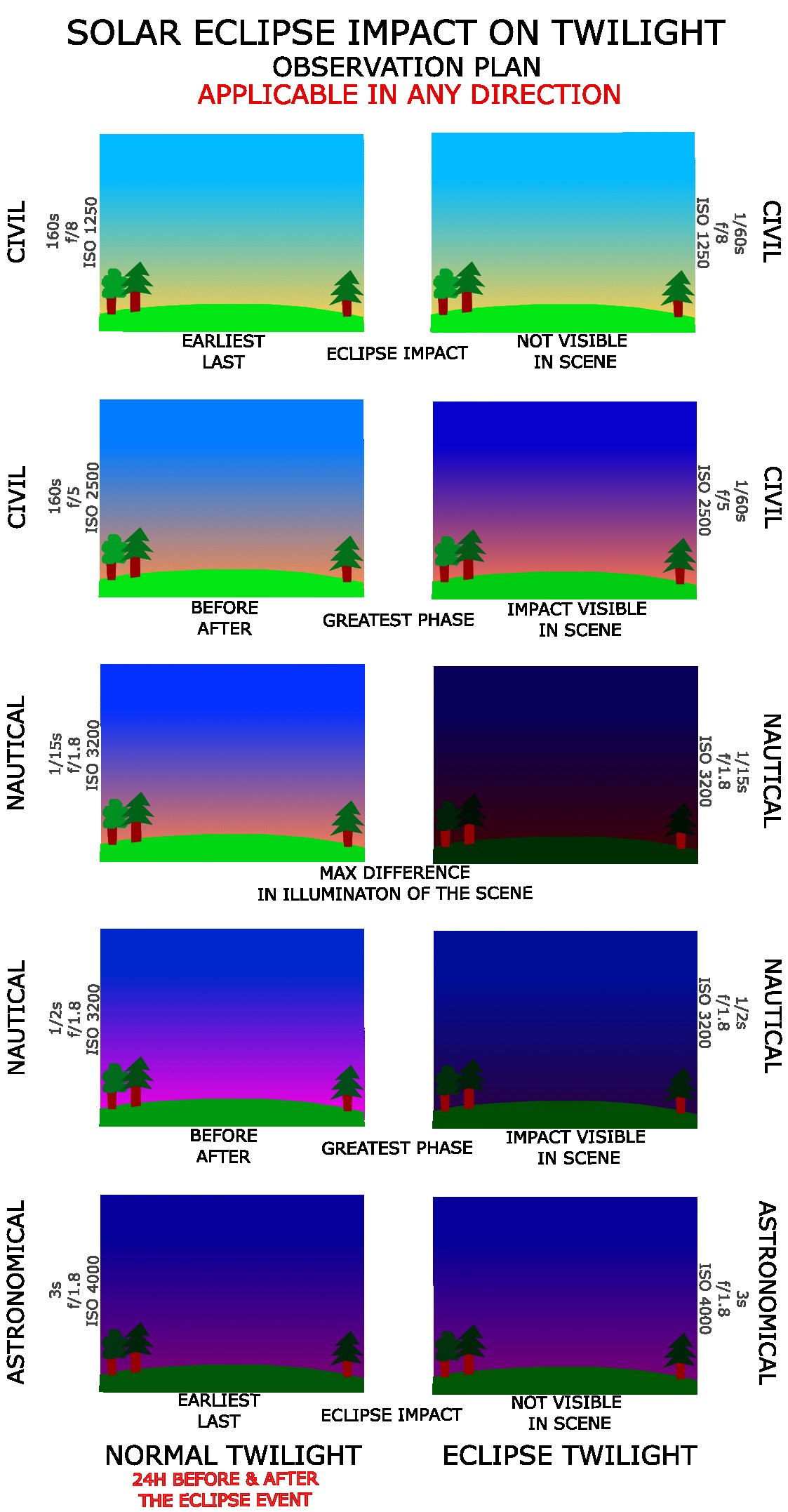
Even the most amateur observation must be done twice. We can do it in two manners. Make the first observation a day before for non-eclipse conditions and repeat it at the eclipse evening or do it another way around where the first will be done by the eclipsed dusk and the other one later by non-eclipsed twilight. More details about it can be found in this article.
Both of them have pros and cons. When you attend the first observation before the eclipse, you will get yourself experienced with the exercise. Even if you make some mistakes, they won’t deteriorate your results, because they can be repeated afterwards. In the case when you attend the first observation during the eclipse, you will have the photography settings adjusted already to the given level of illumination. Next day you can repeat the sequence in roughly the same parameters.
10. OBSERVATION RESULTS
THIS SECTION TO BE COMPLETED AFTER APRIL 8, 2024
11. SUMMARY
This long text includes probably the first serious approach for the solar eclipse below the horizon observation on the continental scale. So far there is only a little work which proves the reports from the event such as this. It clearly means the complete unawareness of local people living in the areas that occasionally become the extensions of the solar eclipse event. If more people know about it, we can expect more, even occasional observation results, especially at the rough extension of the totality path. Conversely, at the extension of deep penumbra, it might be harder to notice this event by looking at the western sky dusk glow just once. Therefore the guideline presented above should help to carry out a good observation from the scientific point of view. All the results will help to understand the tail end of any solar eclipse event, which results in the twilight standstill phenomenon, which is still unknown. The importance of this event is stressed by the best « observation window » of the 12P/Pons-Brooks comet, which wasn’t better since January 1888. It’s worth mentioning, that in 2026 another total solar eclipse below the horizon takes place in Europe. This time the event will be very spectacular, as the umbra extension is to be observed mostly within the civil dusk zone.
References:
- Gulyaev R.A., 1992, On a possible use of total solar eclipse below the horizon for observations of the inner zodiacal light (as applied to the eclipse of June 30 1992), Kluwer Academic Publishers
- Meeus J., 1997, Mathematical Astronomy Morsels I, Willmann-Bell
Links:
- https://www.rocketstem.org/2020/04/04/ice-and-stone-comet-of-week-15/
- El Nino and La Nina – years and intensities
- https://www.solar-eclipse.info/
Wiki:
